Veronika Yablonska . "30 BOSNIAN ARTISTS." Spirit of Bosnia Current Issue, Volume 19 No. 2 (2024): April -- https://www.spiritofbosnia.org/current-issue/30-bosnian-artists/
30 BOSNIAN ARTISTS
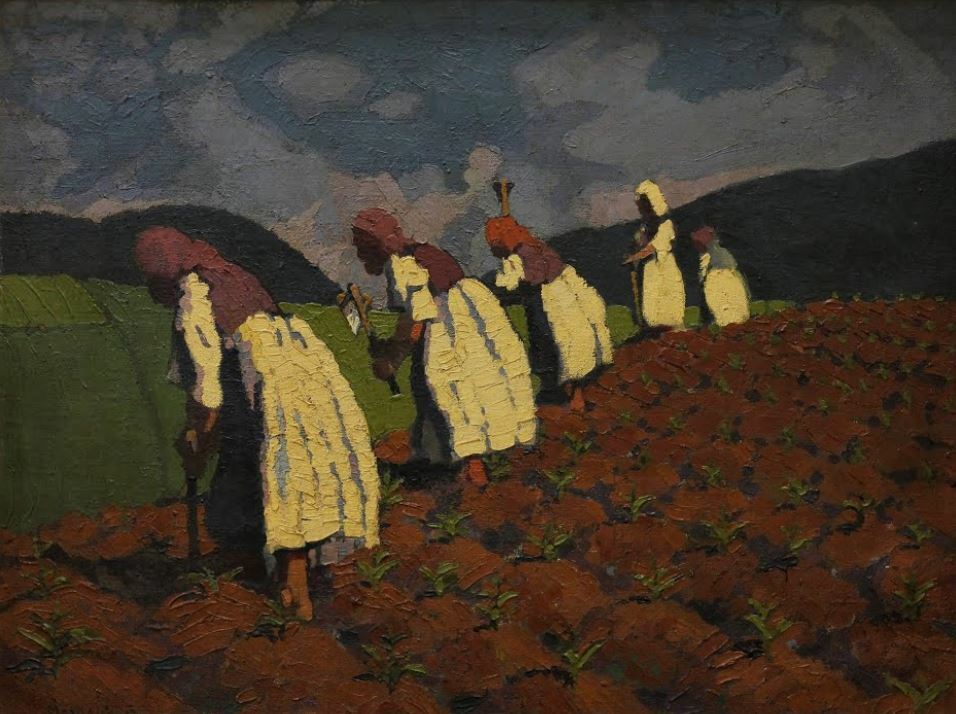
30 BOSNIAN ARTISTS
How they painted life, death, food and wandering and what we can learn from them
If art is a mirror held up to nature, we are very welcome to look in it.
How they painted life, death, food and wandering and what we can learn from them
If art is a mirror held up to nature, we are very welcome to look in it.
In this essay Bosnian artistry is perceived through the lens of the most important stages of human existence: how we love, suffer and rejoice. How we work, appreciate our homes and food. How we wander through the world and how we die. And how we reach immortality after all.
HOW WE LOVE
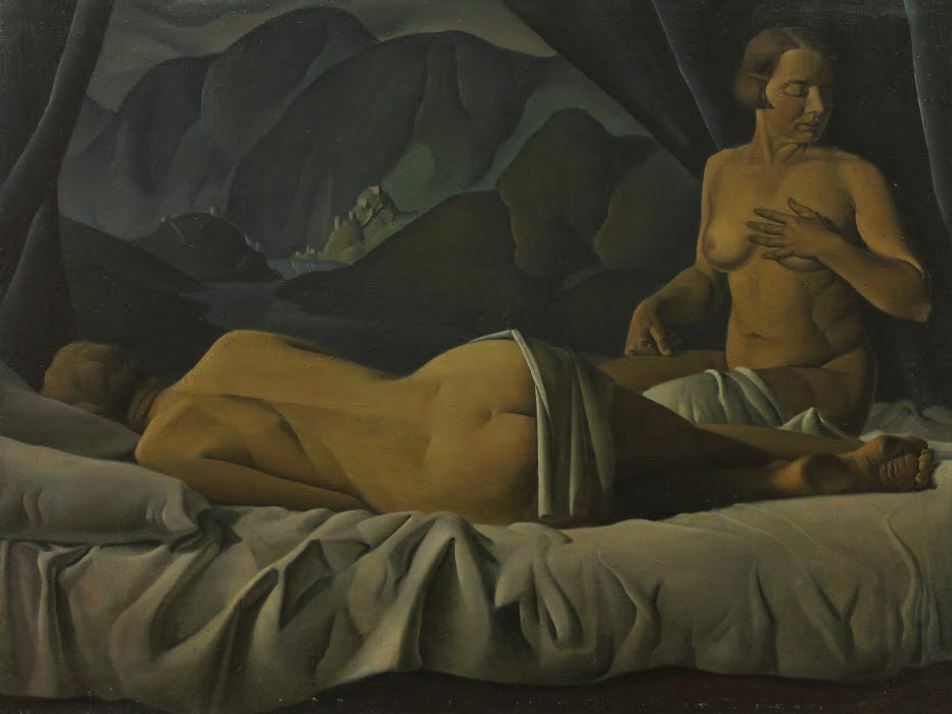
National Gallery of Bosnia and Herzegovina, Đoko Mazalić Na ljetovanju, around 1927, oil on canvas, 97×125 cm, object n. 443
‘Summering’ by Đoko Mazalić brings us to the bedroom of two lovers.
Woman sits, not looking at her partner. She holds her hand almost as she tries to keep her heart from jumping out of the chest.
We can imagine her asking the partner probably the most important question two people can have between them, but what she got must have broken her heart.
The background can symbolise everything the cold silent rocky mountains can be: echoing your own words or an unpleasant frosty morning you would rather skip.
Woman sits, not looking at her partner. She holds her hand almost as she tries to keep her heart from jumping out of the chest.
We can imagine her asking the partner probably the most important question two people can have between them, but what she got must have broken her heart.
The background can symbolise everything the cold silent rocky mountains can be: echoing your own words or an unpleasant frosty morning you would rather skip.
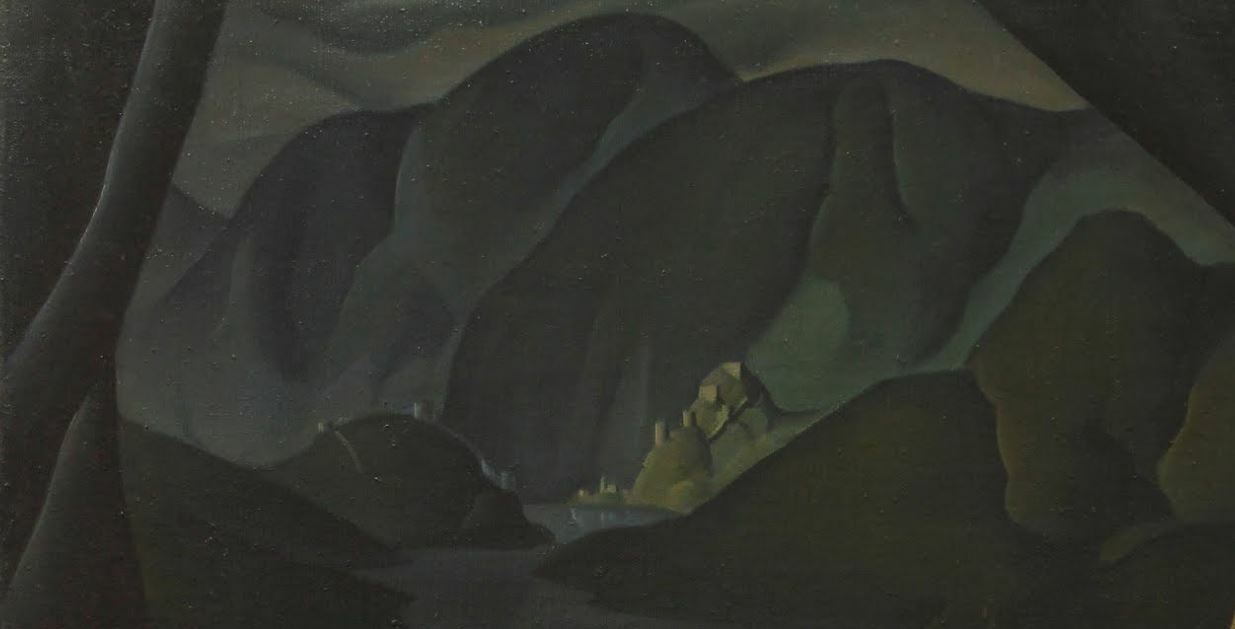
How detailed the background is executed will always catch the attention, whenever we look at this piece, and we will know for sure that the mountains are the part of the answer.
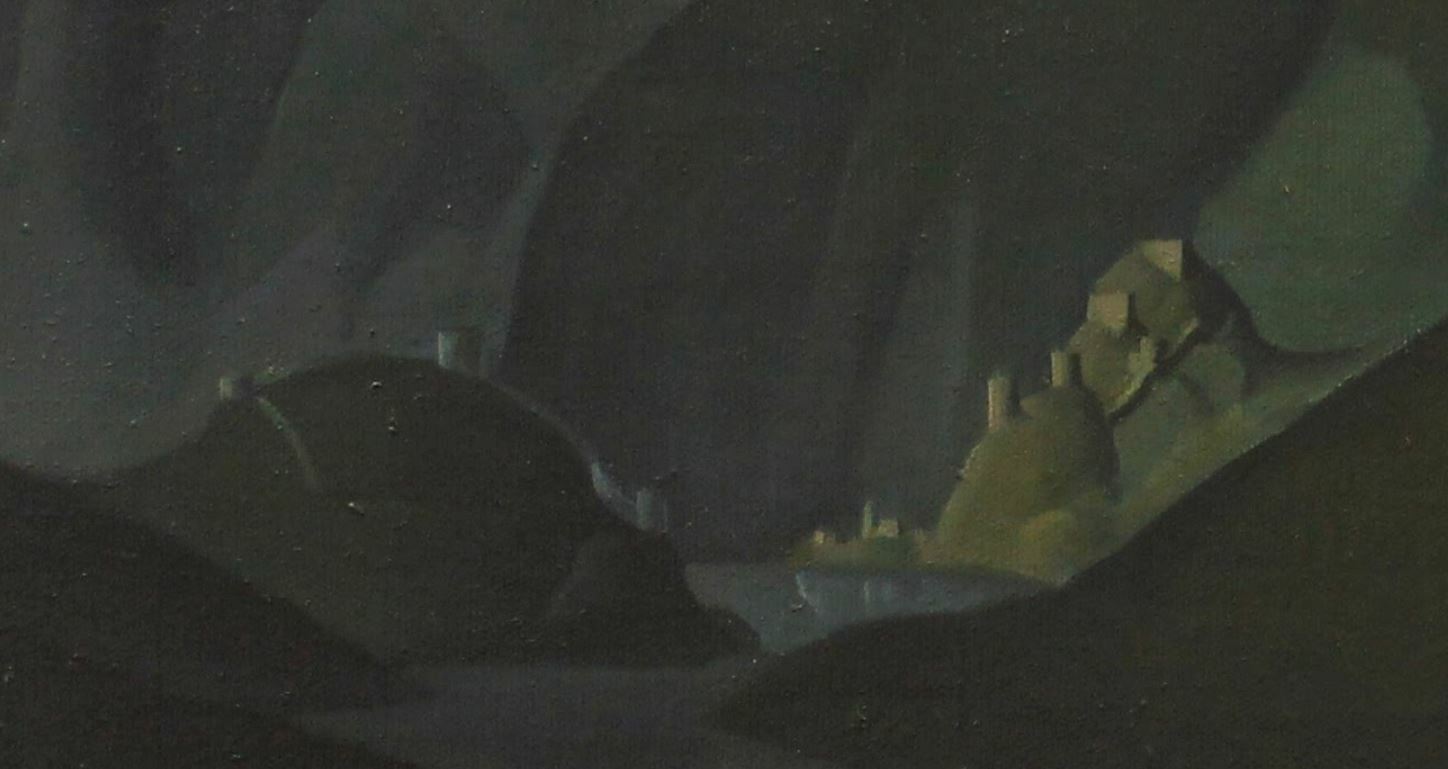
We find continuation of this story in Mazalić’s work 5 years after.
‘A Heroic End’ was created in 1932.
We can see the very same bed. The partner’s gone. Mountain chain behind the woman changed to a single peak with the burning fire on it.
‘A Heroic End’ was created in 1932.
We can see the very same bed. The partner’s gone. Mountain chain behind the woman changed to a single peak with the burning fire on it.
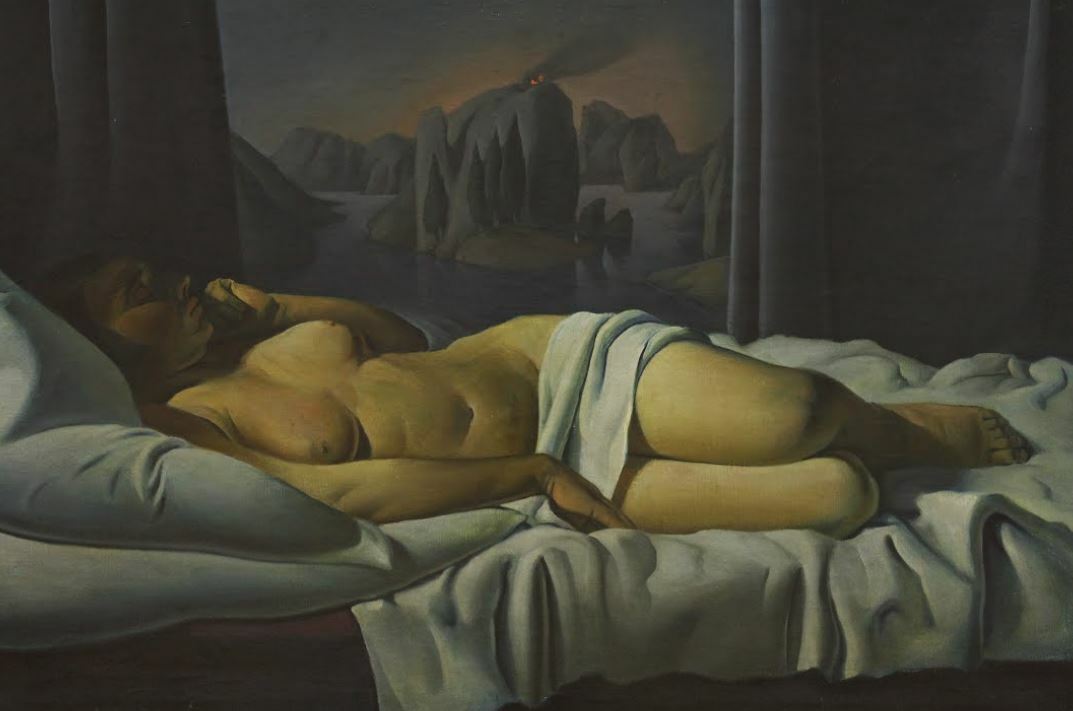
National Gallery of Bosnia and Herzegovina, Đoko Mazalić Herojski kraj, 1927, oil on canvas, 87,5×125 cm, object n. 438
We can imagine this as the story of The Tower, one of the Major Arcana in the Tarot.
Through the centuries it’s been the symbol of despair, disappointment and failure of all hopes.
This symbolism of The Tower is followed by another Bosnian artist, Kantardžić Narcis.
Almost 90 years after ‘A Heroic End’ he created the piece picturing the tower in flames.
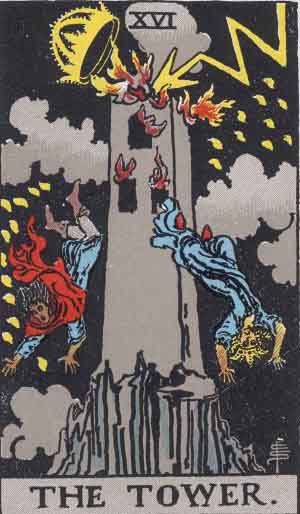
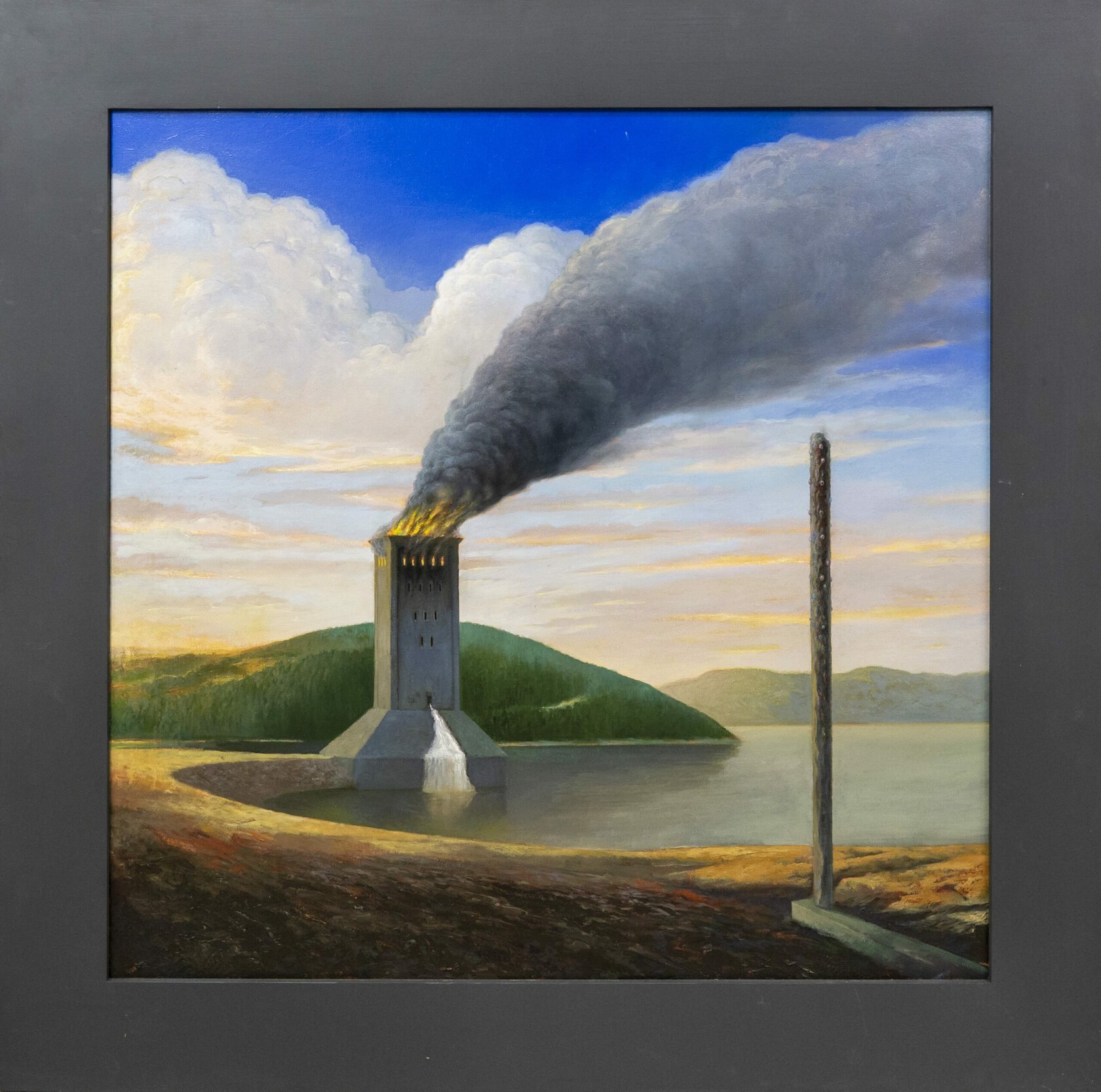
Kantardžić Narcis, 2020
So, despair and failure of hopes. But how about we imagine some sort of happy ending here?
Let’s look at warning beacons of Gondor in the second film of ‘The Lord of The Rings’.
Let’s look at warning beacons of Gondor in the second film of ‘The Lord of The Rings’.
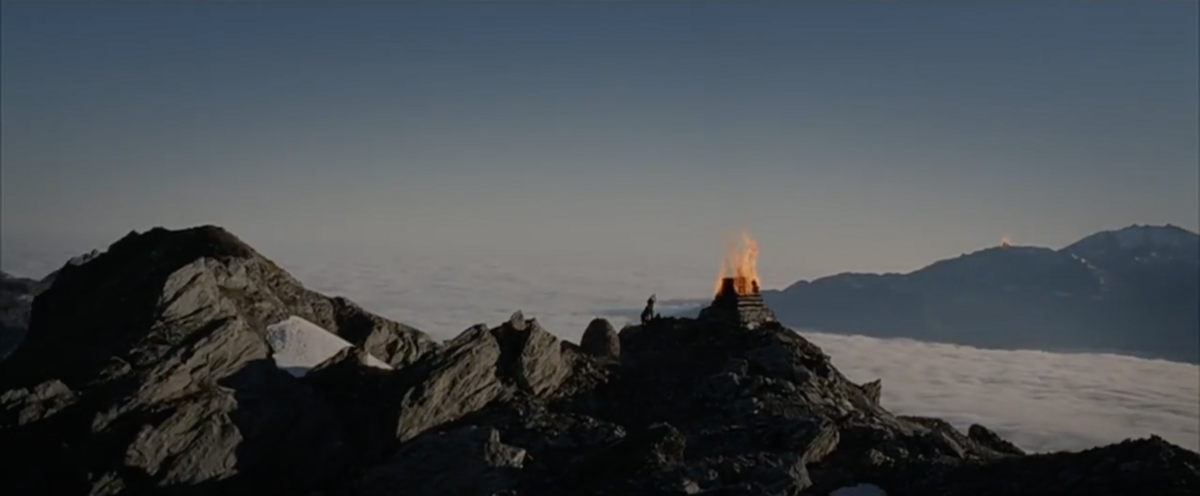
From ‘The Lord of the Rings: The Return of the King’
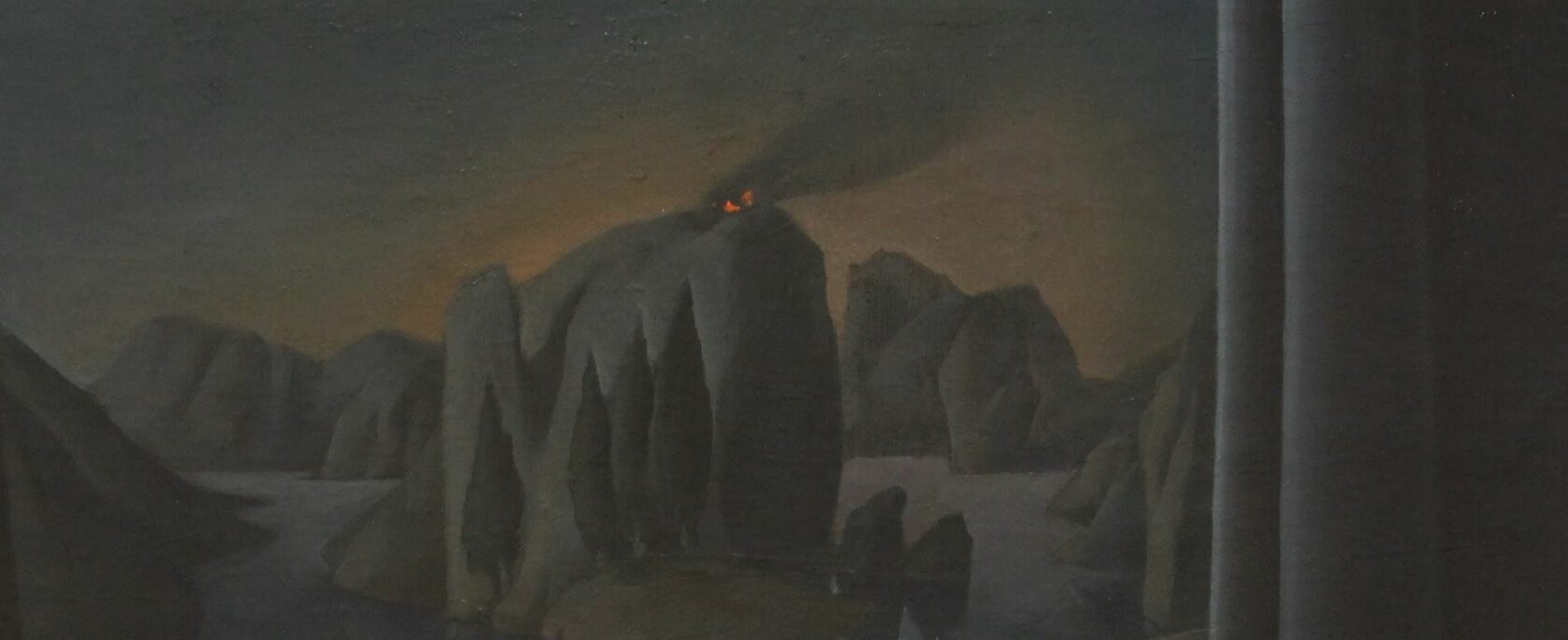
Đoko Mazalić, A Heroic End, detail
There is the story of hope and joy behind this.
So, king Denethor, blinded by tragedy and fear, refuses to ask for help when the Orks’ threat is inevitable.
Hobbit Pippin sneaks out and fires the beacon himself and this means a cry for help is sent out.
Then, we get an incredibly inspiring and eye-watering scene of beacons firing all the way out until Aragorn sees the message in Edoras, the capital of Rohan.
So, king Denethor, blinded by tragedy and fear, refuses to ask for help when the Orks’ threat is inevitable.
Hobbit Pippin sneaks out and fires the beacon himself and this means a cry for help is sent out.
Then, we get an incredibly inspiring and eye-watering scene of beacons firing all the way out until Aragorn sees the message in Edoras, the capital of Rohan.
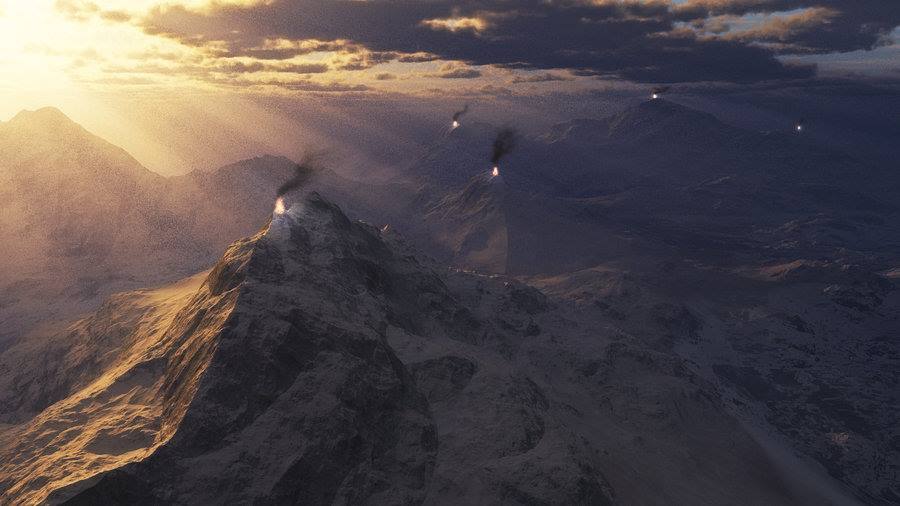
From ‘The Lord of the Rings: The Return of the King’
King of Rohan, Theoden, delivers his iconic line ‘And Rohan will answer’ and that’s it.
Happy ending of this episode, the friendship is recovered, the help is coming and in the heroic battle we find our glory.
Because that’s exactly how Mazalić decided to name his piece.
Amazing thing about art is that we decide what happens when we look at it.
Is this lady devastated like in the Tower of Tarot or sending for (and getting) help like in ‘The Lord of The Rings’? It’s up to us.
Tables turn in the piece of Jovan Bijelić from 1921.
If previous stories were about a lady getting the answer that breaks her heart, now the lady is in charge of breaking the heart.
How the lover is looking at her, how he’s half-turned to her and how his palm is patiently resting on his lap. He’s waiting.
The lady looks straight forward though, showing almost no compassion, except that the curve of her eyebrows shows some sadness, perhaps.
The green trees behind them hint: there still is some life in this love. Just let the seasons pass and you’ll be fine.
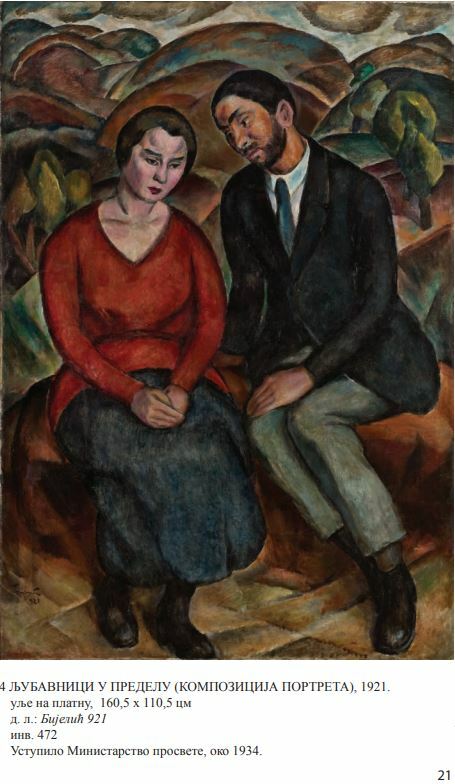
National Museum in Belgrade
HOW WE SUFFER
And that’s how we wait. And that’s. How. We. Wait.
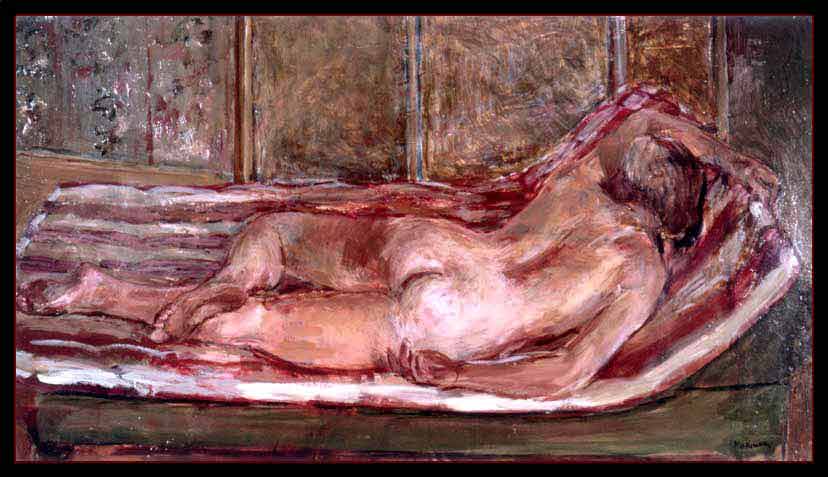
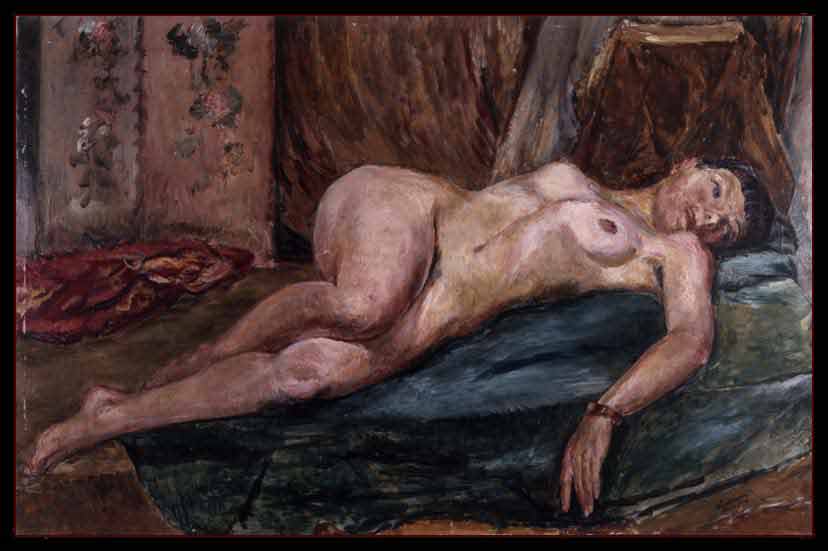
Kosta Hakman, Akt, source: Project Rastko
Đoko Mazalić’s and Kosta Hakman’s paintings of women in their beds give a very wide range of feelings and sensations.
Still, most of all, almost like Bella in ‘The New Moon’ (and allow me to speak of the ‘Twilight’ saga in a non-ironic way!), they are frozen, numb and alone. And seasons pass.
Still, most of all, almost like Bella in ‘The New Moon’ (and allow me to speak of the ‘Twilight’ saga in a non-ironic way!), they are frozen, numb and alone. And seasons pass.
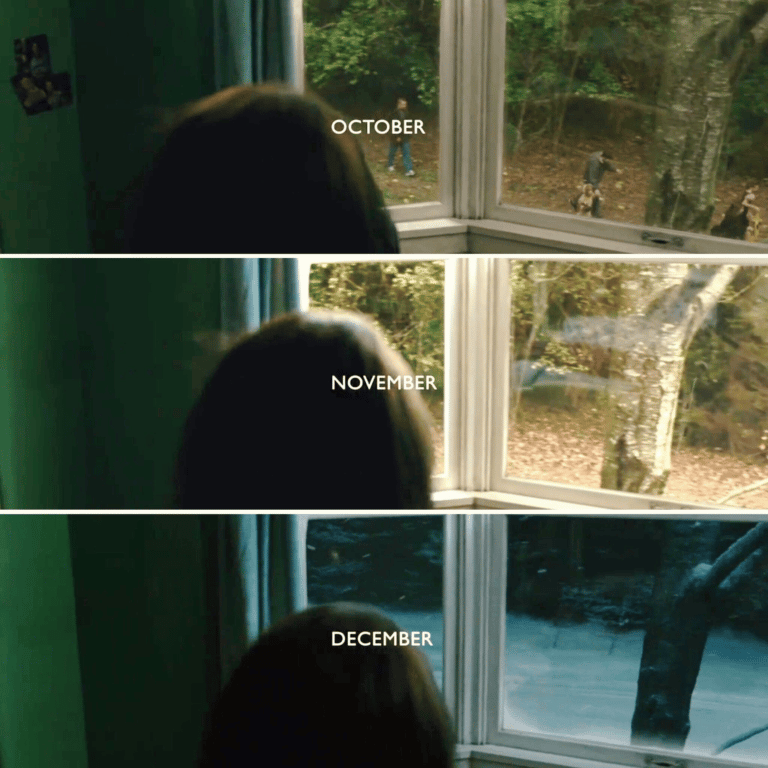
From ‘The Twilight Saga: New Moon’
We can see those women in poses that people usually don’t rest in. Those are not ‘let me have my nap’ poses, but when feelings and events subdue us and we give up for a moment.
Or when we step out of the survival mode, feel safe and allow ourselves to stay in bed, sleep and recover, and this may take days, weeks, months, until we recharge and are ready to take a step.
The thing is that we, women and girls, have been all the same 500 years ago, 100 and 20: powerful in our courage to love, to keep the hearts open for love and friendships, courage to be present and to speak out.
Courage to wear the heart on your sleeve.
Or when we step out of the survival mode, feel safe and allow ourselves to stay in bed, sleep and recover, and this may take days, weeks, months, until we recharge and are ready to take a step.
The thing is that we, women and girls, have been all the same 500 years ago, 100 and 20: powerful in our courage to love, to keep the hearts open for love and friendships, courage to be present and to speak out.
Courage to wear the heart on your sleeve.
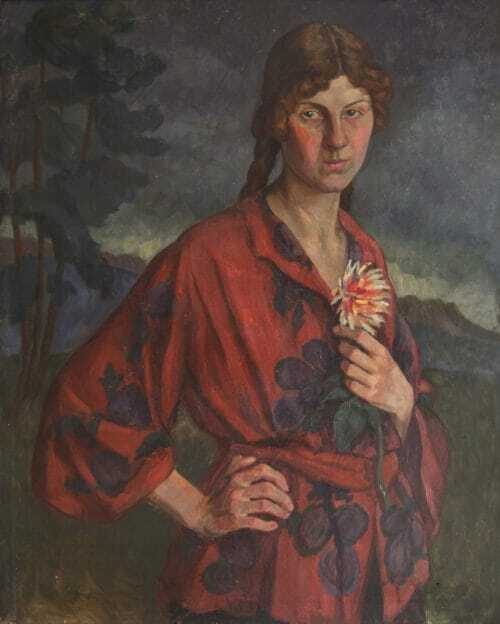
National Gallery of Bosnia and Herzegovina, Roman Petrović, Portret sestre, 1917, oil on canvas, 86×70,5 cm, object n. 1170
Petrović’s ‘Portrait of the Sister’ is a very strong work. It’s a statement.
The red clothes with bold floral patterns. Calm, almost demanding look of two dark eyes. Rosy cheeks. Two braids. Hand on the hip. Heavy sky, still some light breaking through the clouds.
And the central element of the portrait – a chrysanthemum looking more like a flame, than a flower.
Everything about this piece is giving hope and a very strong will to live.
And that’s how we live.
The red clothes with bold floral patterns. Calm, almost demanding look of two dark eyes. Rosy cheeks. Two braids. Hand on the hip. Heavy sky, still some light breaking through the clouds.
And the central element of the portrait – a chrysanthemum looking more like a flame, than a flower.
Everything about this piece is giving hope and a very strong will to live.
And that’s how we live.
HOW WE REJOICE
We look in the mirror and see the person we know, and we see hope.
We take a shower, we clean our bed and the workplace, we breathe in the fresh air through the window that probably hasn’t been open for days and weeks. We resurrect.
In his poem ‘Madderfield’ Bosnian poet Mak Dizdar says:
We take a shower, we clean our bed and the workplace, we breathe in the fresh air through the window that probably hasn’t been open for days and weeks. We resurrect.
In his poem ‘Madderfield’ Bosnian poet Mak Dizdar says:
My hope is a finger in a pillar of light
My light lieth in that hope
With this faith I keep my faith
This faith which has no name”.
My light lieth in that hope
With this faith I keep my faith
This faith which has no name”.
Todor Švrakić created this piece, ‘Slavoluk’ in 1919. It’s festive and bright, the sky is nice and blue, two women talk in the sun and one of them is holding flowers.
As we go through the circle of life, when we are in love and broken-hearted, then we are numb and waiting, then we rise up in hope and then, finally, we find something to celebrate.
As we go through the circle of life, when we are in love and broken-hearted, then we are numb and waiting, then we rise up in hope and then, finally, we find something to celebrate.
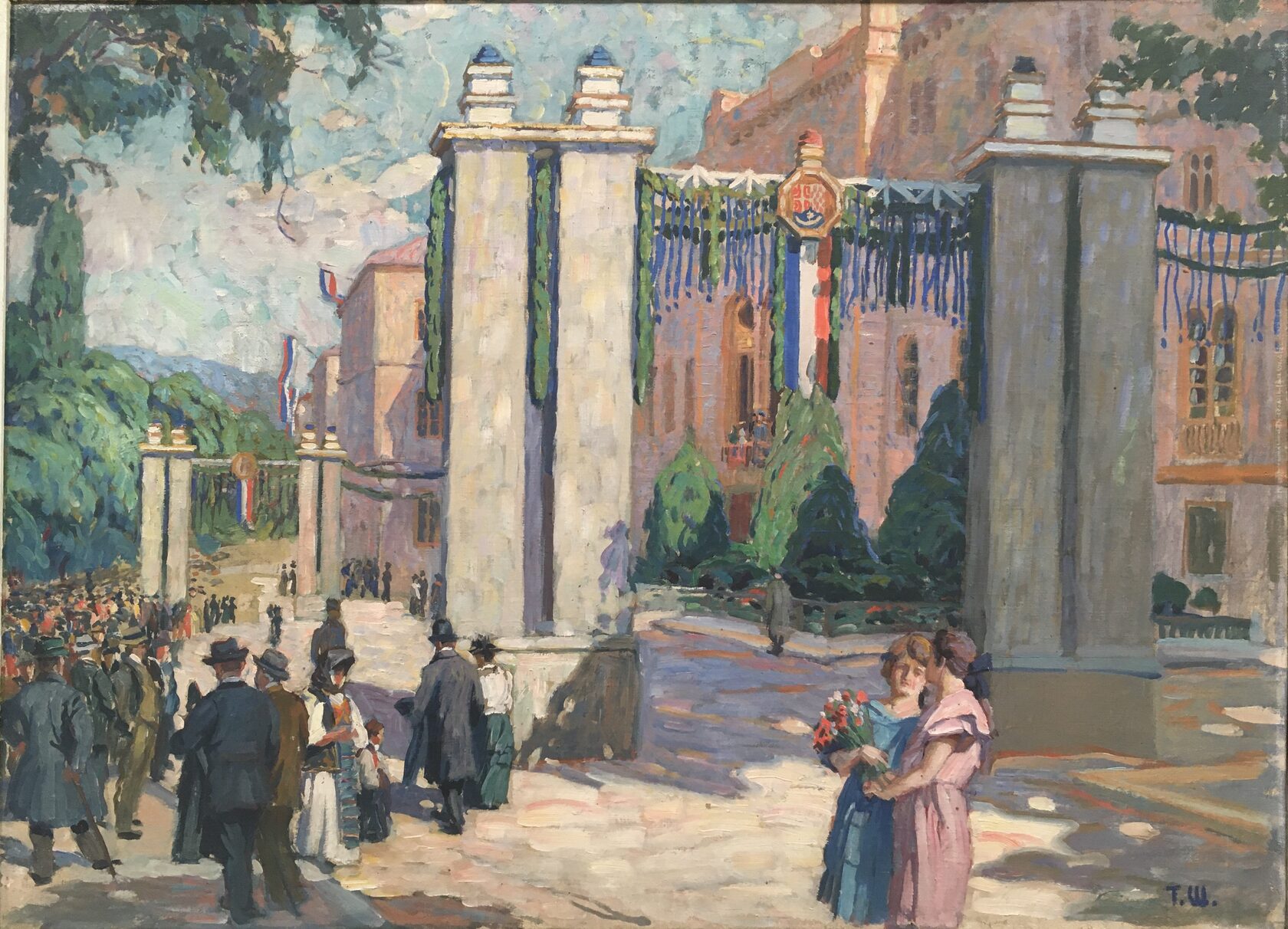
National Gallery of Bosnia and Herzegovina, Todor Švrakić Slavoluk, 1919. oil on canvas, 69×94 cm, object n. 454
Friendships, honesty, partnerships, trust, joy in hard work done together and the rest shared together. Cigarettes after a busy day, small gossip while the breaks.
Beautiful human experience captured on canvas giving us the chance to learn from the characters on how to celebrate life.
Beautiful human experience captured on canvas giving us the chance to learn from the characters on how to celebrate life.
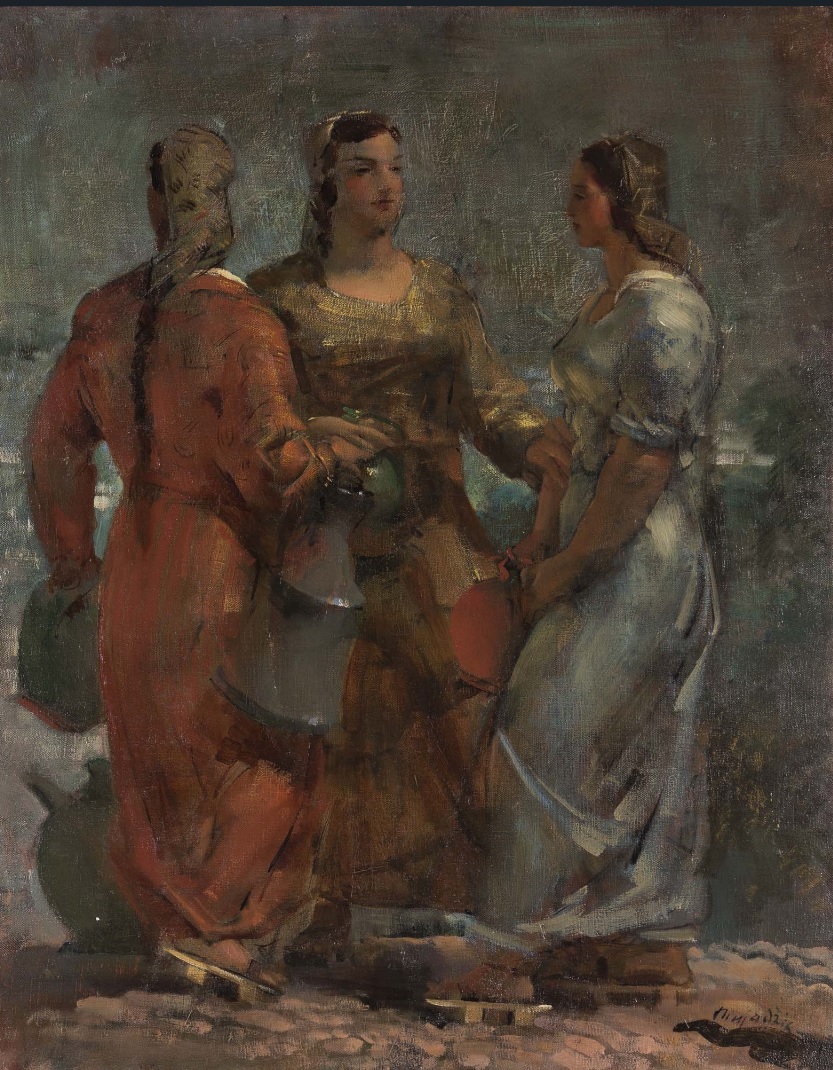
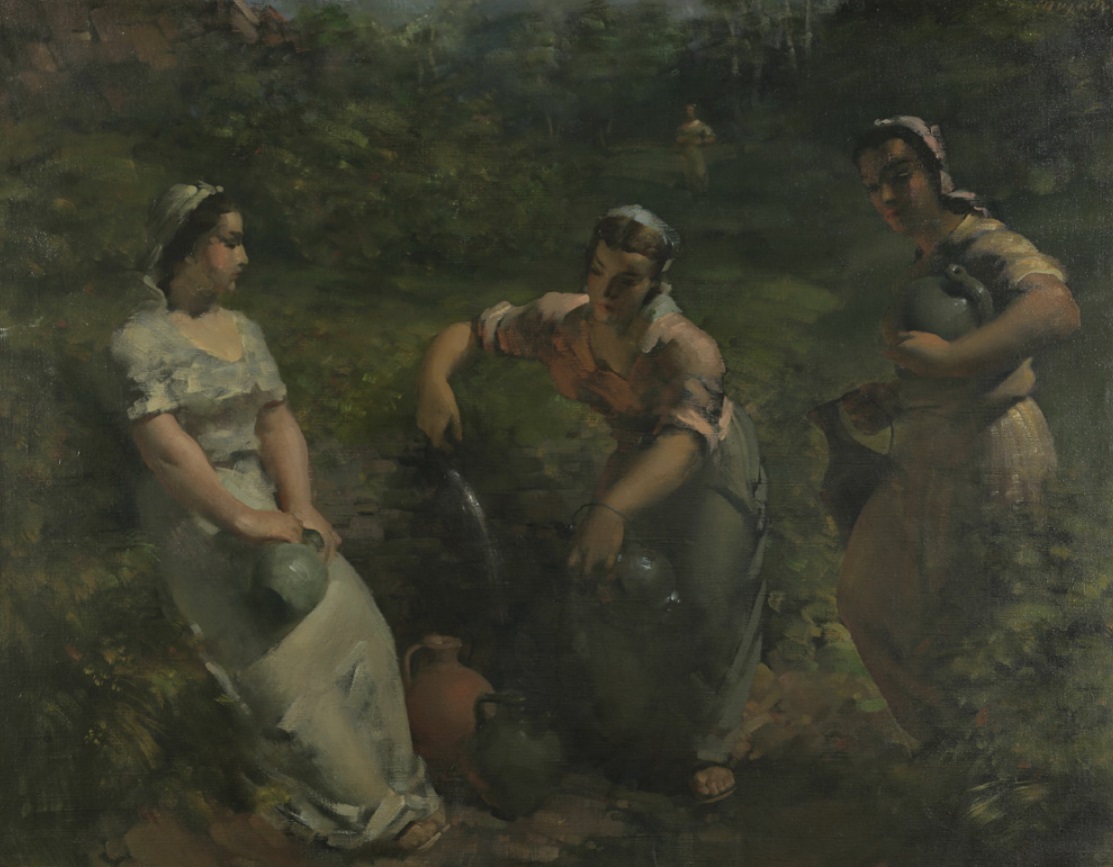
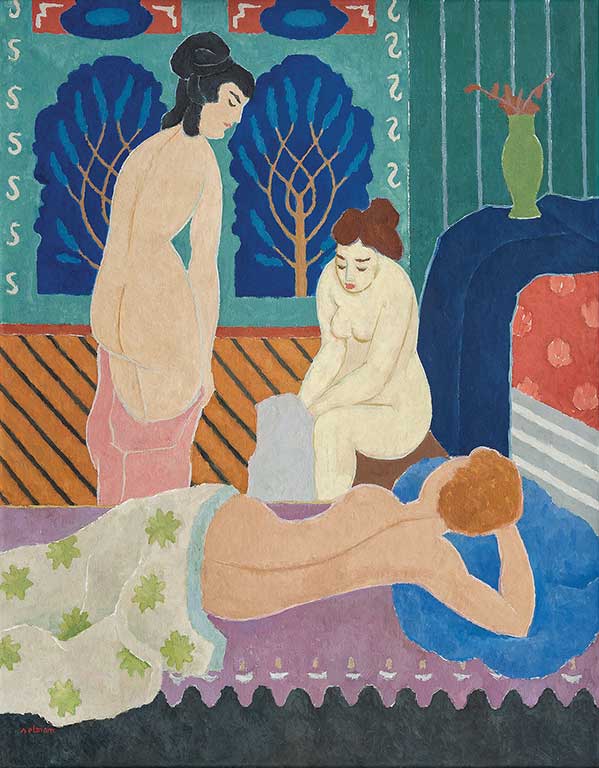
Like this piece by Đoko Mazalić. There is so much life in it, we can literally feel the warm sunny day, the chattering of men, the smell of summer trees and grass and cigarettes and fabrics.
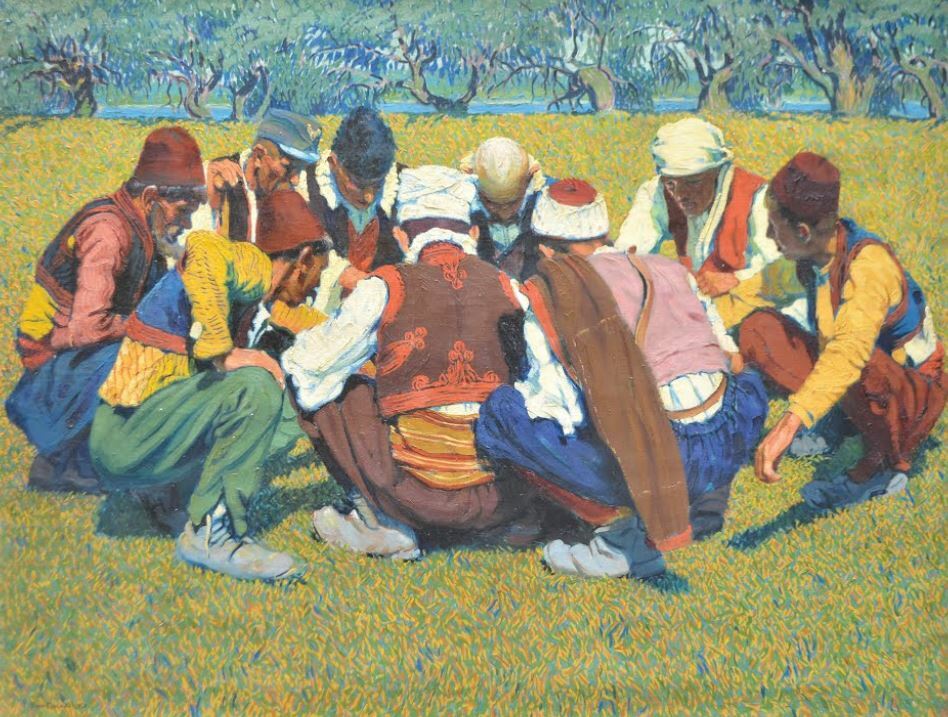
National Gallery of Bosnia and Herzegovina, Đoko Mazalić Kockari, 1920, oil on canvas, 115,5×154 cm, object n. 3271
What’s truly fascinating about ‘Gamblers’ by Mazalić is how precise he is with the age of his characters.
We can see the wrinkles and grey beards, as well as young yet unshaved faces. We know they all learn from each other – wisdom through the years or energy of the youth, they all find something important in one another.
We can see the wrinkles and grey beards, as well as young yet unshaved faces. We know they all learn from each other – wisdom through the years or energy of the youth, they all find something important in one another.
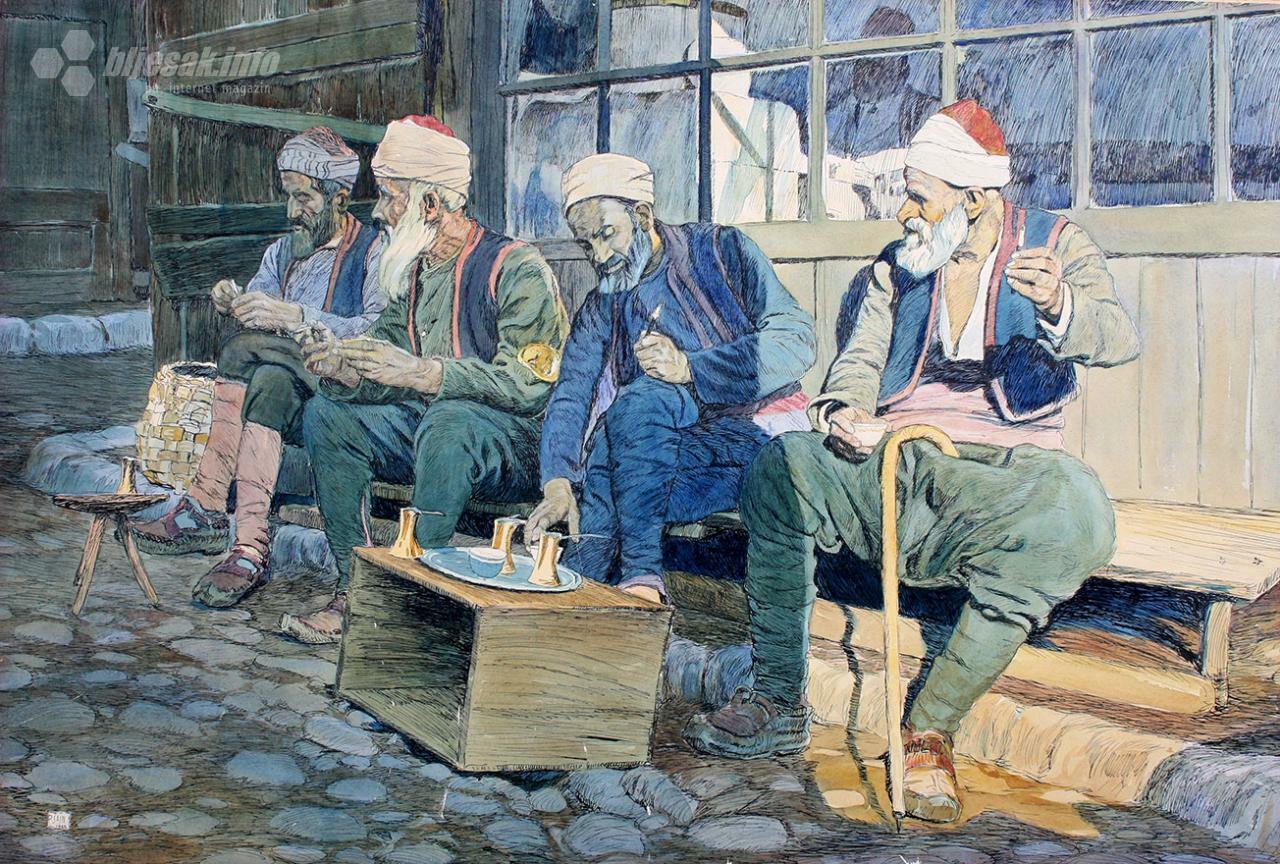
Muzej Sarajeva, Petar Šain, Stari Muslimani piju kafu
They talk, they smoke, they share a joke or two. They share stories of adventures and battles.
Some of those we may overhear in ‘Dervish and the Death’ by Meša Selimović, as the narrator, the religious person, recalls his service with soldiers:
Some of those we may overhear in ‘Dervish and the Death’ by Meša Selimović, as the narrator, the religious person, recalls his service with soldiers:
The nights were steamy and hot, and the plain breathed quietly in the moonlight, like the sea; countless frogs in the invisible swamps cut us off from the rest of the world with their piercing voices, flooding us with a terrible drone that was calmed only by the misty dawns, while white and gray vapors drifted over us like at the very beginning of the world.
Hardest to bear was the punctuality of these changes, their changelessness. In the morning the mists turned roseate, and the most pleasant part of the day began, without the steamy heat, without the mosquitoes, without the tortures of nights spent half-awake.
At that time we would fall into a deep sleep, as if into a well”.
Hardest to bear was the punctuality of these changes, their changelessness. In the morning the mists turned roseate, and the most pleasant part of the day began, without the steamy heat, without the mosquitoes, without the tortures of nights spent half-awake.
At that time we would fall into a deep sleep, as if into a well”.
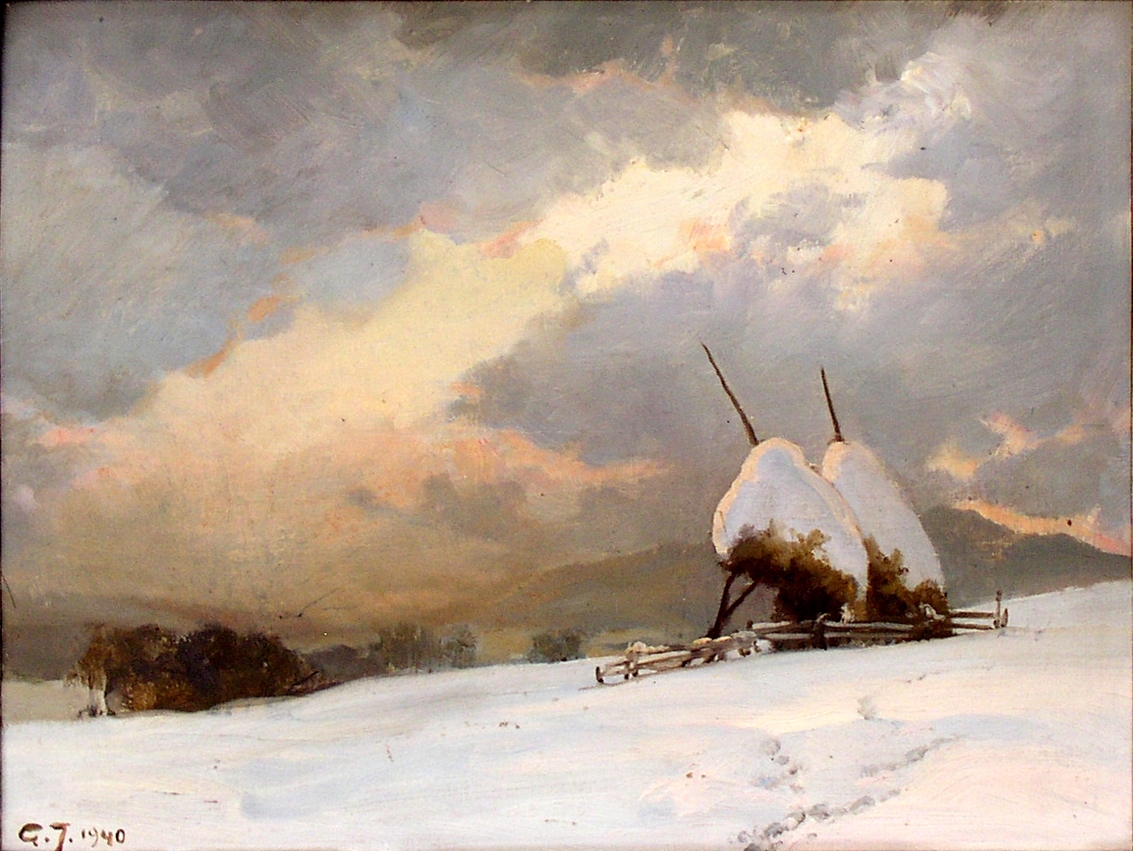
National Gallery of Bosnia and Herzegovina, Gabriel Jurkić
When it rained, it was even worse. The horizon narrowed around us.
We squatted together and said nothing, tormented by the cold, as if winter were already setting in, or we just talked about anything at all, or sang, irritable and dangerous, like wolves.
Our tents leaked and gray rain dripped down on us; water seeped up under our cots. The ground turned into an impassable quagmire, and we were trapped in our misery, as always.
The soldiers drank, played dice under canopies of blankets, quarreled and fought”.
We squatted together and said nothing, tormented by the cold, as if winter were already setting in, or we just talked about anything at all, or sang, irritable and dangerous, like wolves.
Our tents leaked and gray rain dripped down on us; water seeped up under our cots. The ground turned into an impassable quagmire, and we were trapped in our misery, as always.
The soldiers drank, played dice under canopies of blankets, quarreled and fought”.
As they recall their heroic days, they drink their coffee, they rest.
And they work.
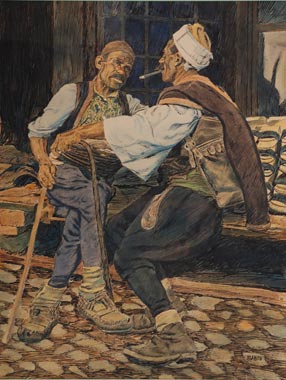
Petar Šain, RAZGOVOR NA ĆEPENKU, private collection
HOW WE WORK
Bosnian painters gave us lots of amazing pieces celebrating hard work.
Gabriel Jurkic’s ‘Kod ovaca’ from 1918 tells a story of how life, work and nature intertwine.
It’s almost giving the Shakespearean sense of ‘All the world’s a stage’ as he describes how the states of human beings flow from one to another.
Gabriel Jurkic’s ‘Kod ovaca’ from 1918 tells a story of how life, work and nature intertwine.
It’s almost giving the Shakespearean sense of ‘All the world’s a stage’ as he describes how the states of human beings flow from one to another.
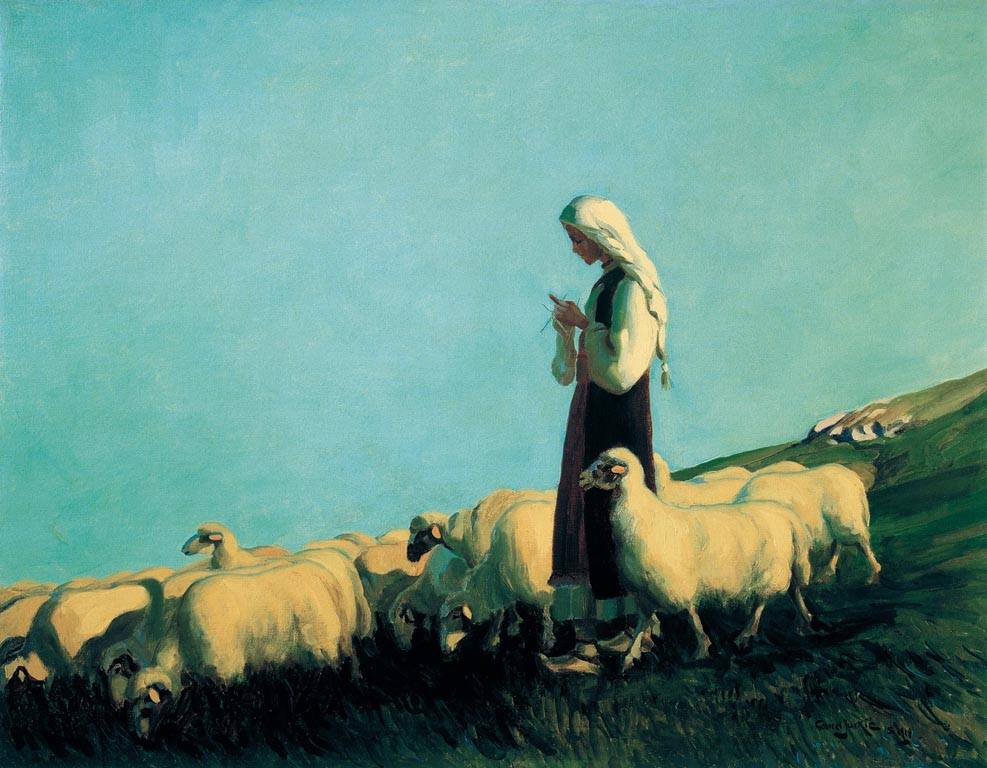
Gabrijel Jurkic, Kod Ovaca, 1918, Memorial gallery of Gabriel Jurkić
We can see the sheeps, some of them are younger, some of them are older. Some of them are busy with the grass, some of them are captured by the environment, they are interested, excited.
The shepherdess is busy knitting, and, of course, the yarn is a co-product from the sheeps. Somehow even her hair collected into a braid is a part of this play.
We take care of the sheeps and they give us the yarn in return.
We knit the clothes for the family, while our mothers braid our hair. And then their hands are cold and we give them the mittens we made.
And then these hands take care of the field. The circle closed.
We can see a similar story in Gabriel Jurkic’s work ‘Pogled na Livno’, but here nature itself is a character, as well as the village in the corner.
The horizon is light, it’s blue and green, the village is detailed and this gives the whole another perspective to look from.
The shepherdess is busy knitting, and, of course, the yarn is a co-product from the sheeps. Somehow even her hair collected into a braid is a part of this play.
We take care of the sheeps and they give us the yarn in return.
We knit the clothes for the family, while our mothers braid our hair. And then their hands are cold and we give them the mittens we made.
And then these hands take care of the field. The circle closed.
We can see a similar story in Gabriel Jurkic’s work ‘Pogled na Livno’, but here nature itself is a character, as well as the village in the corner.
The horizon is light, it’s blue and green, the village is detailed and this gives the whole another perspective to look from.
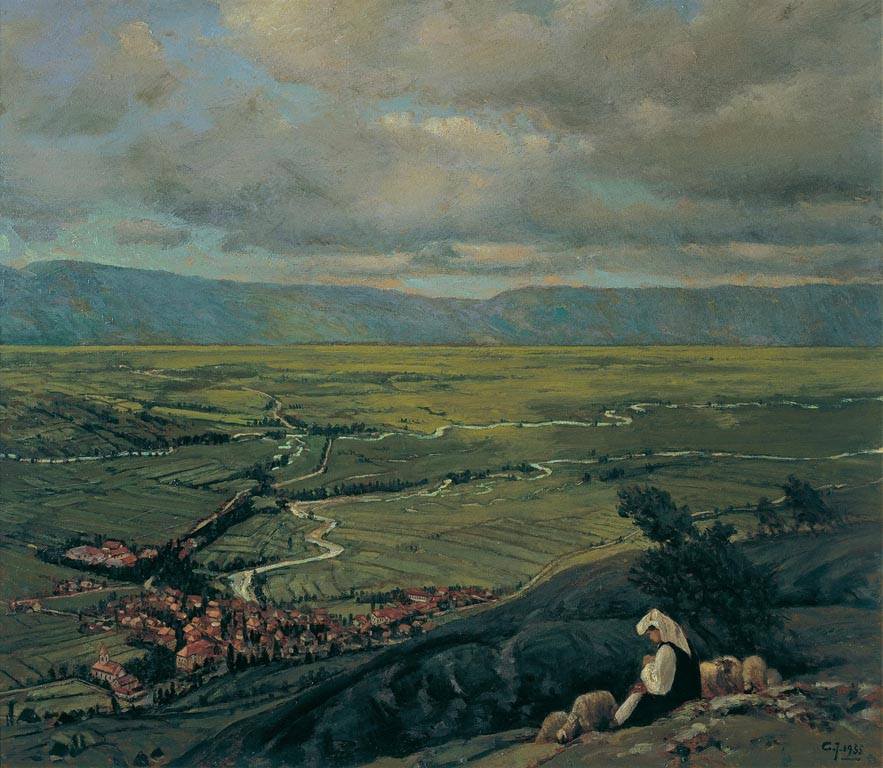
Gabriel Jurkic, Pogled na Livno, 1955, Memorial gallery of Gabriel Jurkić
As of the partnership. As of the people, who work, support and provide for each other without envy and competition, but rather working on one goal all together.
Apparently, the shepherdess is focused on her knitting, rather than on appreciating nature around her. She doesn’t have time for this.
More of that – in Đoko Mazalić’s ‘Diggers’ from 1918.
Apparently, the shepherdess is focused on her knitting, rather than on appreciating nature around her. She doesn’t have time for this.
More of that – in Đoko Mazalić’s ‘Diggers’ from 1918.
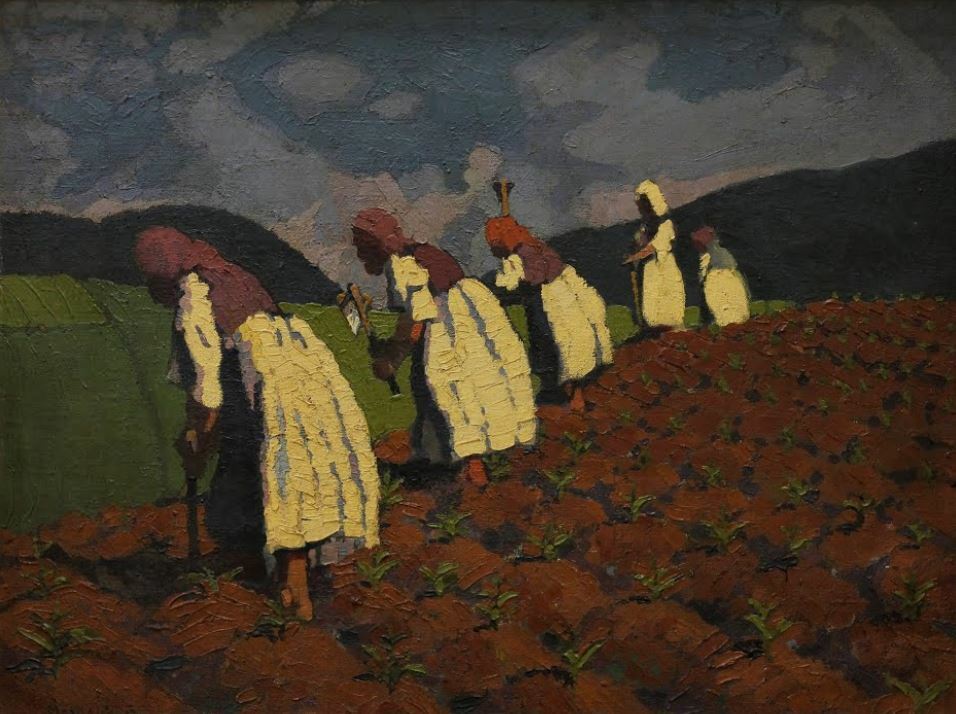
National Gallery of Bosnia and Herzegovina, Đoko Mazalić Kopači, 1918, oil on canvas, 64×84 cm, object n. 3630
It appears less happy due to the cloudy grey sky, heavier horizon and overall postures of women.
They have no time to be captured by wonders of nature, they work hard.
Still, the pattern of the soil they are working with gives some sort of calmness to the eye.
This sets the pace of the painting. The workers know what they are doing today and will know what they are doing tomorrow.
The tranquillity of the monotonous work.
They have no time to be captured by wonders of nature, they work hard.
Still, the pattern of the soil they are working with gives some sort of calmness to the eye.
This sets the pace of the painting. The workers know what they are doing today and will know what they are doing tomorrow.
The tranquillity of the monotonous work.
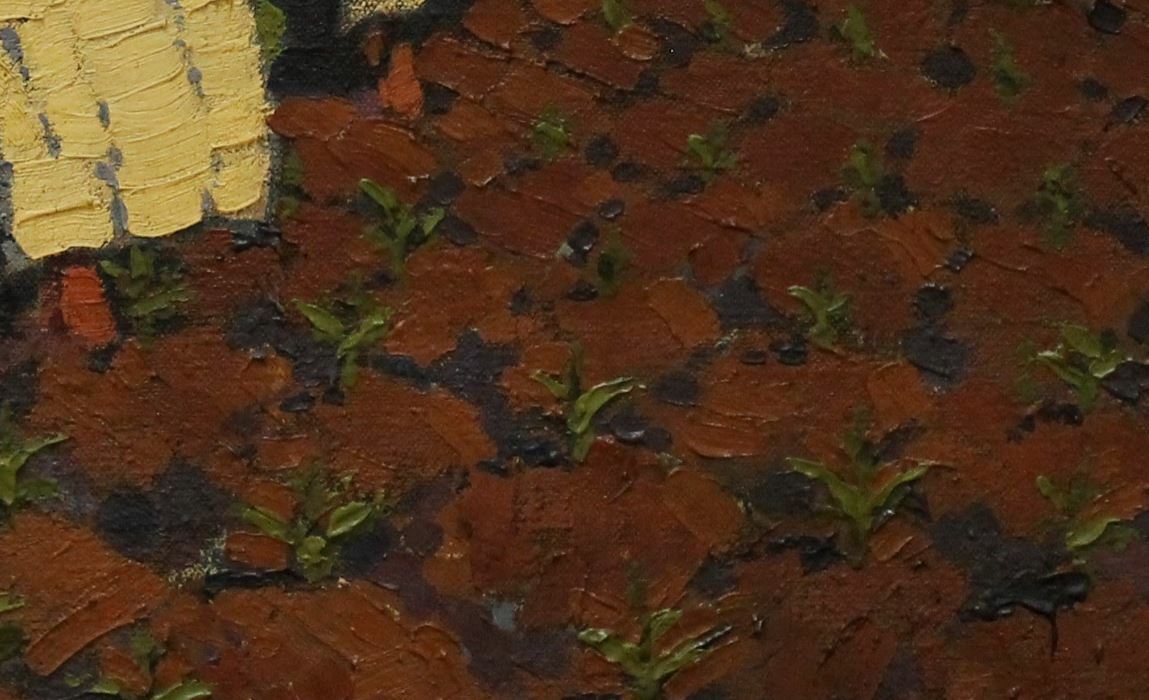
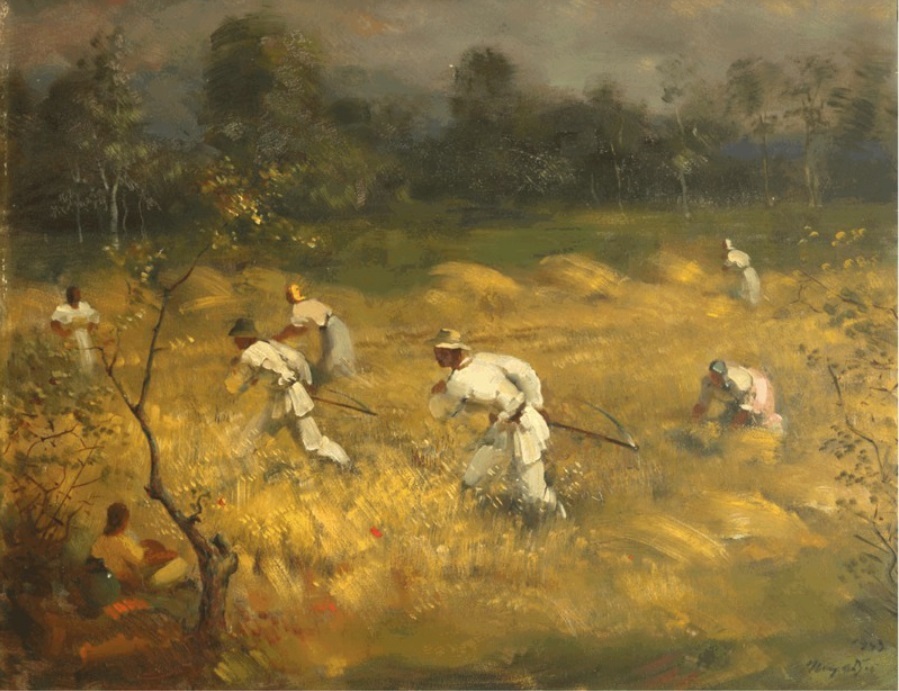
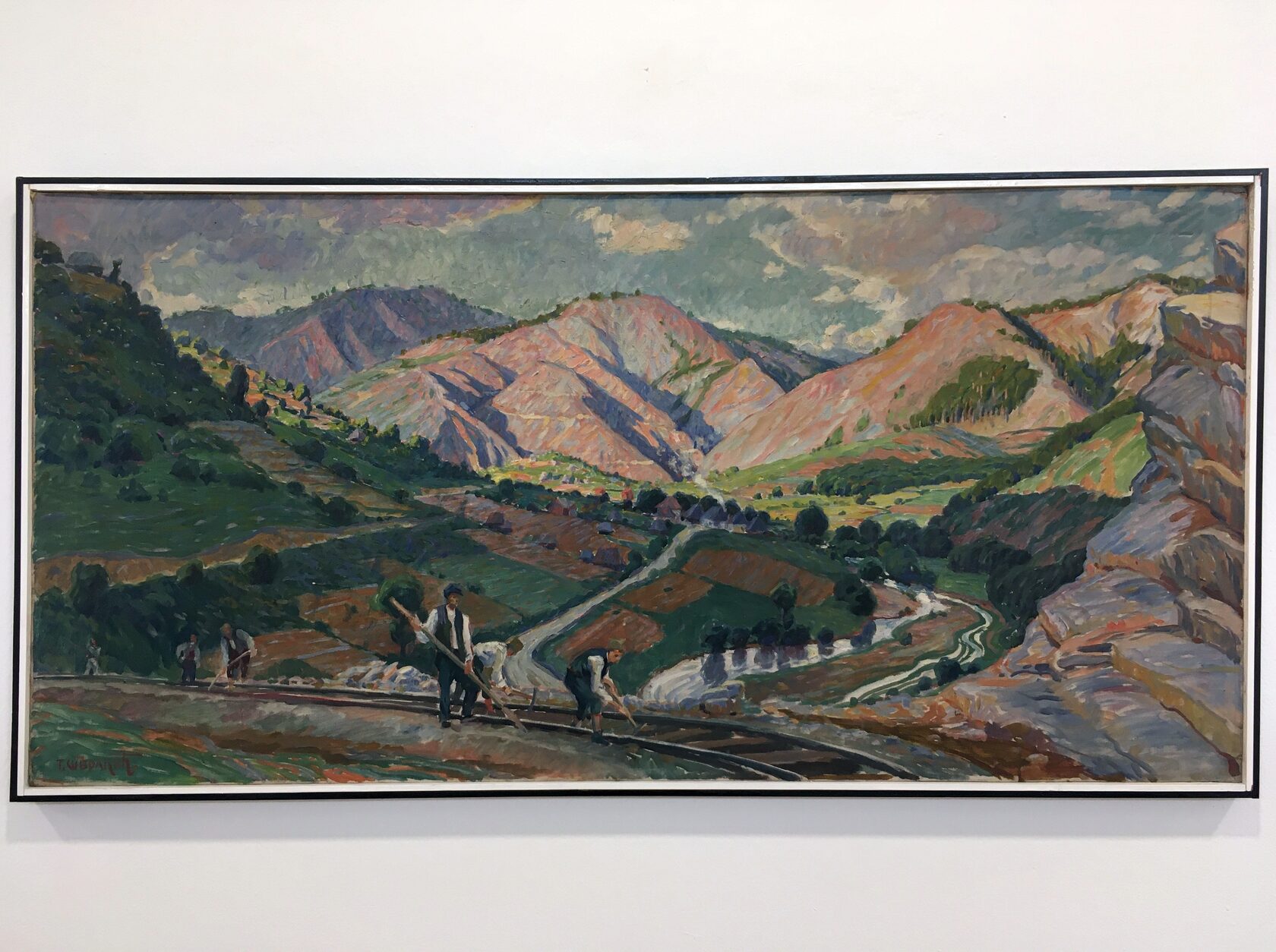
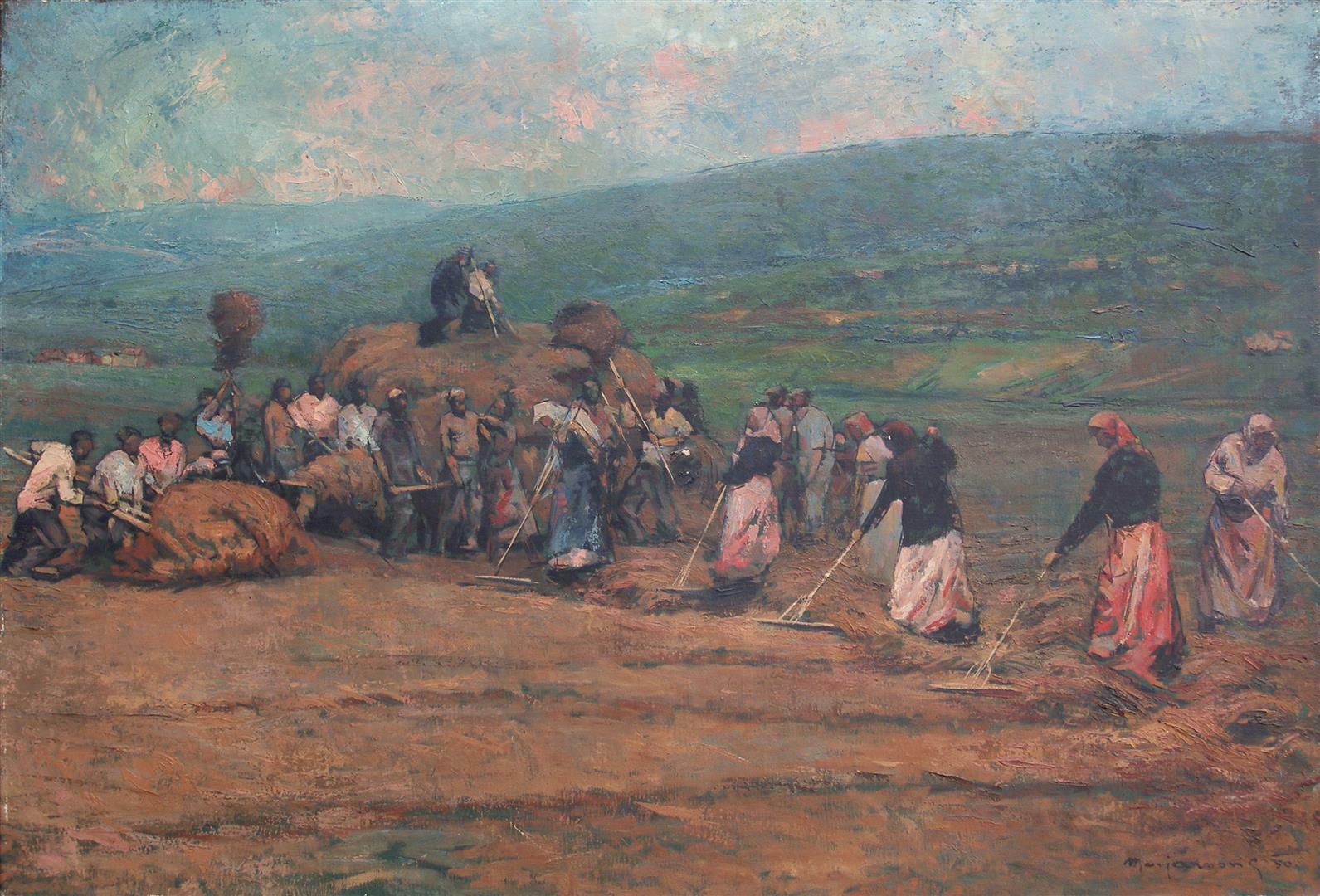
HOW WE COME HOME
And when we finish the work, we come home.
Absolutely surely there’s something about family and home in Bosnian culture that stands out. You can feel it through all forms.
Arguably, Safet Zec is one of the most important figures in Bosnian art. He created pieces that portray tender love and admiration of the home comfort.
Absolutely surely there’s something about family and home in Bosnian culture that stands out. You can feel it through all forms.
Arguably, Safet Zec is one of the most important figures in Bosnian art. He created pieces that portray tender love and admiration of the home comfort.
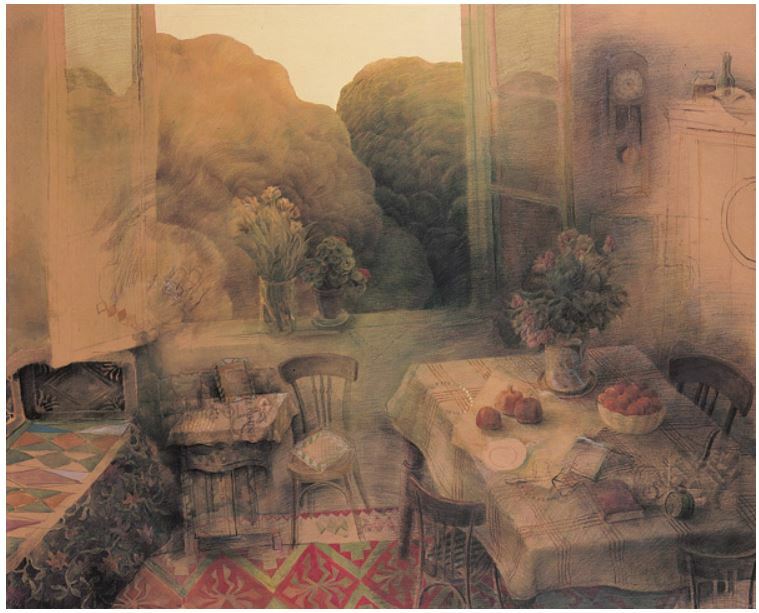
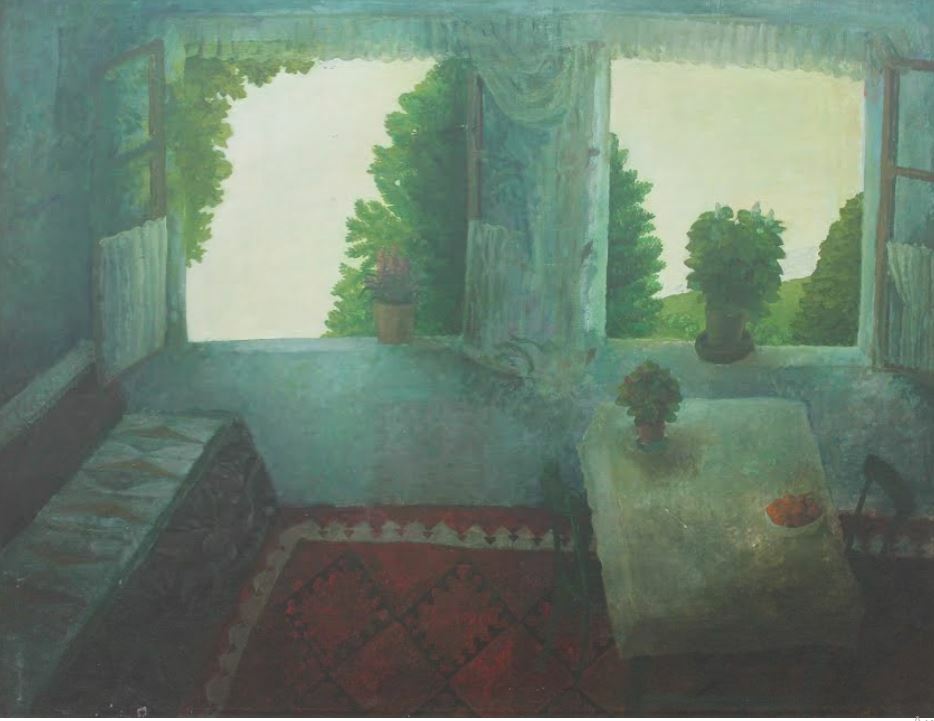
National Gallery of Bosnia and Herzegovina, Safet Zec Soba moje sestre, oil on canvas, 92×120 cm 3420
Even though there are no people in these works, you can still feel the strong presence of family through how the artist named these paintings – My Sister’s Room and The Room of my Mother.
In many ways Safet Zec’s works remind of classic Bosnian film ‘Kod amidže Idriza’ directed by Pjer Žalica.
In many ways Safet Zec’s works remind of classic Bosnian film ‘Kod amidže Idriza’ directed by Pjer Žalica.
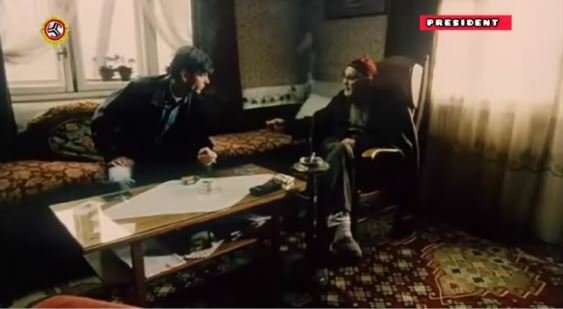
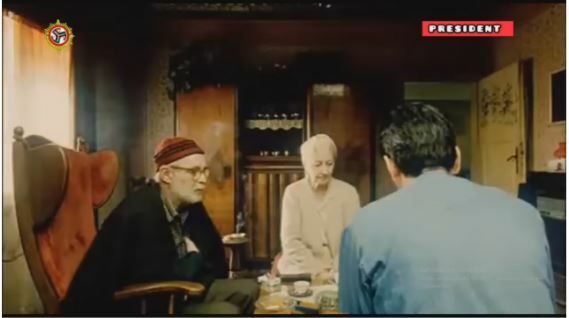
From the film ‘Kod amidže Idriza’
It’s a story about a family being disconnected and reunited again, as it is unfolding similarly to Zec’s works in terms of soft colour spectrum and overall feeling of cosiness.
Unlike Safet Zec, painter Omer Mujadžić in his works puts more people into the interior.
See the paintings by Omer Mujadžić and Behaudin Selmanovic collected by Prof. Aida Abadžić-Hodžić for ‘Bosnian Experiences’:
Unlike Safet Zec, painter Omer Mujadžić in his works puts more people into the interior.
See the paintings by Omer Mujadžić and Behaudin Selmanovic collected by Prof. Aida Abadžić-Hodžić for ‘Bosnian Experiences’:
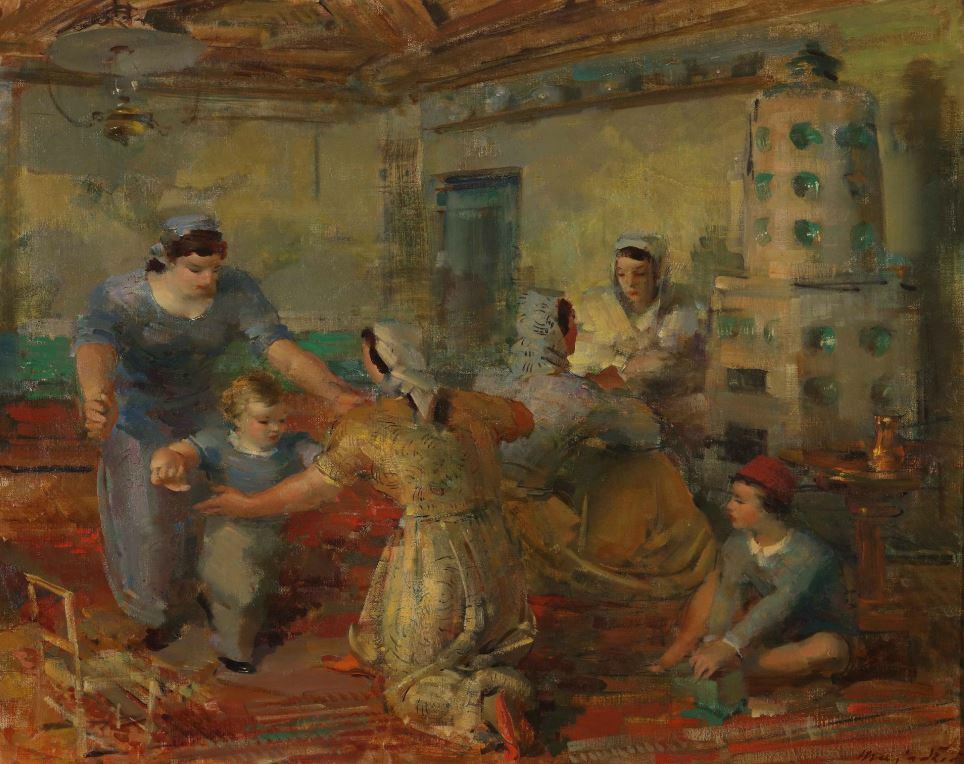
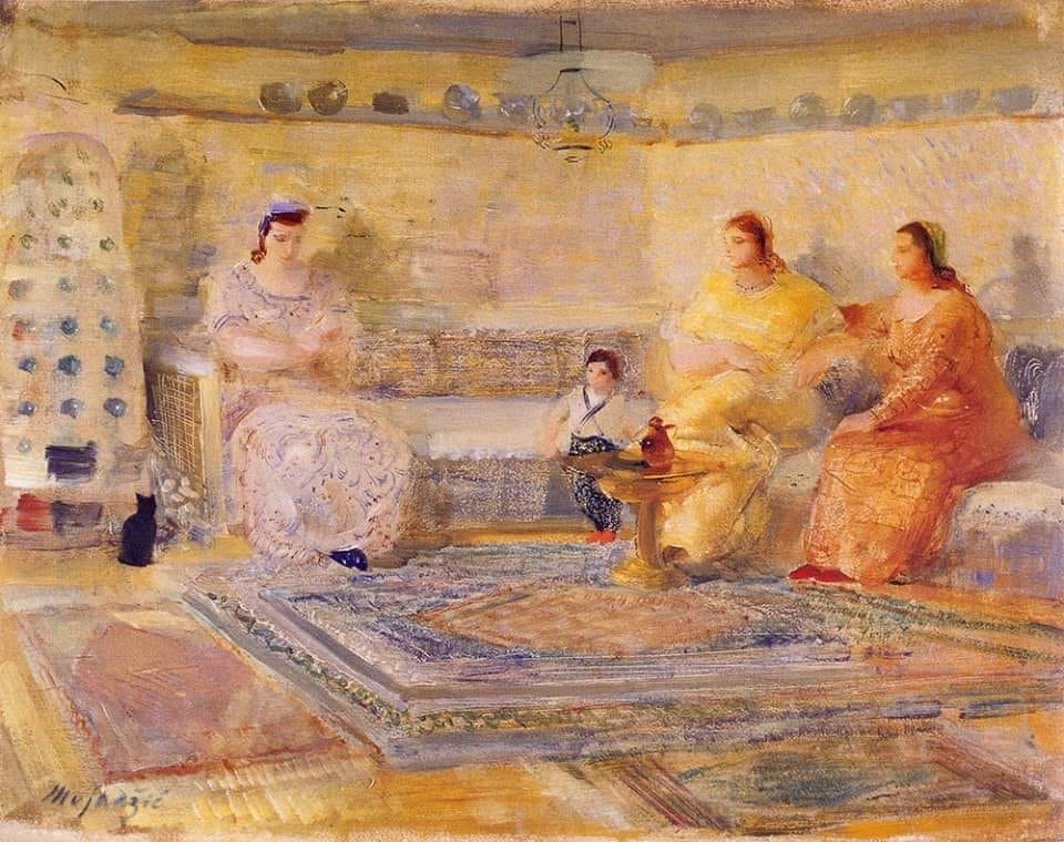
Omer Mujadžić, Bosanska soba, 1939
‘What does it mean to have a home for me?’, we should ask ourselves while looking at these paintings.
Is it the place where we’ve grown up or where we’re growing now? Is it the place where we feel secure?
Is it the place where we have freedom to be ourselves and to create?
Is it the place where we’ve grown up or where we’re growing now? Is it the place where we feel secure?
Is it the place where we have freedom to be ourselves and to create?
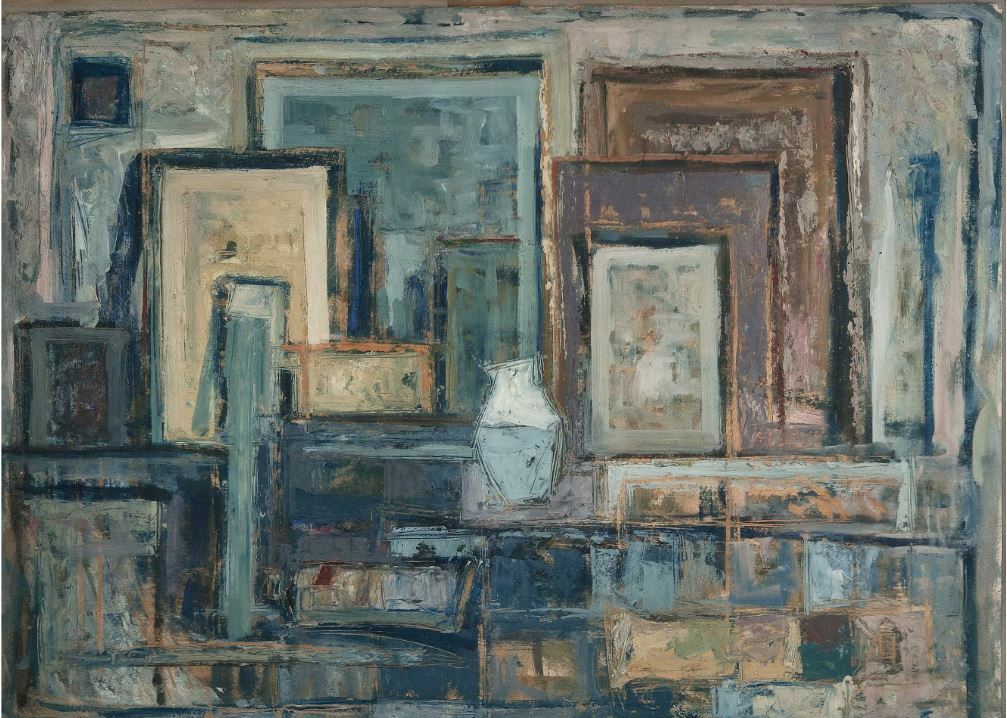
National Gallery of Bosnia and Herzegovina, Mustafa Pezo Enterijer, 1959, tempera on cabord, 52×71 cm, object n. 1156
In some way, Interior by Mustafa Pezo gives us the answer or at least a hint.
As he portrays his atelier, it’s easy to imagine frames rather as mirrors, whereas the artist decided not to get very detailed with the particular pieces.
Thus, home is the place where we can see ourselves clearly.
Home is childhood, laughter, freedom to be who you are.
And food made by parents.
As he portrays his atelier, it’s easy to imagine frames rather as mirrors, whereas the artist decided not to get very detailed with the particular pieces.
Thus, home is the place where we can see ourselves clearly.
Home is childhood, laughter, freedom to be who you are.
And food made by parents.
HOW WE EAT
We eat in hundreds of places throughout our lifetime, in different cities with different people.
Still, eating at home and sharing food is a whole other philosophy.
We can see how much attention the director of ‘Kod amidže Idriza’ gives to this issue.
Still, eating at home and sharing food is a whole other philosophy.
We can see how much attention the director of ‘Kod amidže Idriza’ gives to this issue.
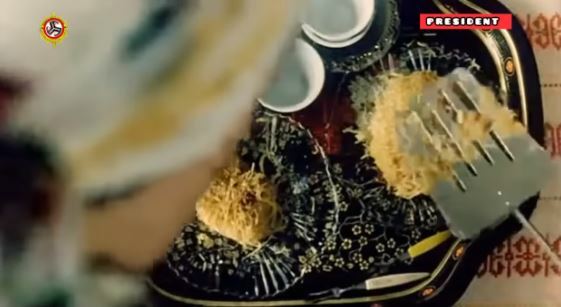
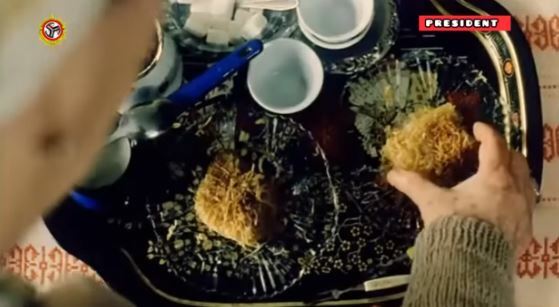
From the film ‘Kod amidže Idriza’
There is the scene in the movie, where Sabira, one of the main characters, measures the pieces of cake that she’s going to serve and then decides to put on the bigger one for her nephew Fuke.
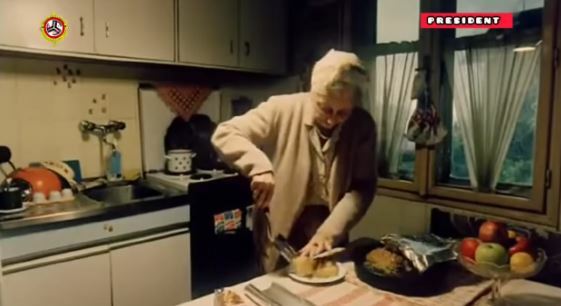
From the film ‘Kod amidže Idriza’
Together with paintings, all of that gives food some sort of ritual meaning.
As well as in the context of working hard for your own bread, we can look at the work of Enver Štaljo from year 1956.
The young man holds his bread like a baby, with both hands, he embraces it to his chest.
He looks down on it and his whole face gives the look of admiration to the loaf of bread.
As well as in the context of working hard for your own bread, we can look at the work of Enver Štaljo from year 1956.
The young man holds his bread like a baby, with both hands, he embraces it to his chest.
He looks down on it and his whole face gives the look of admiration to the loaf of bread.
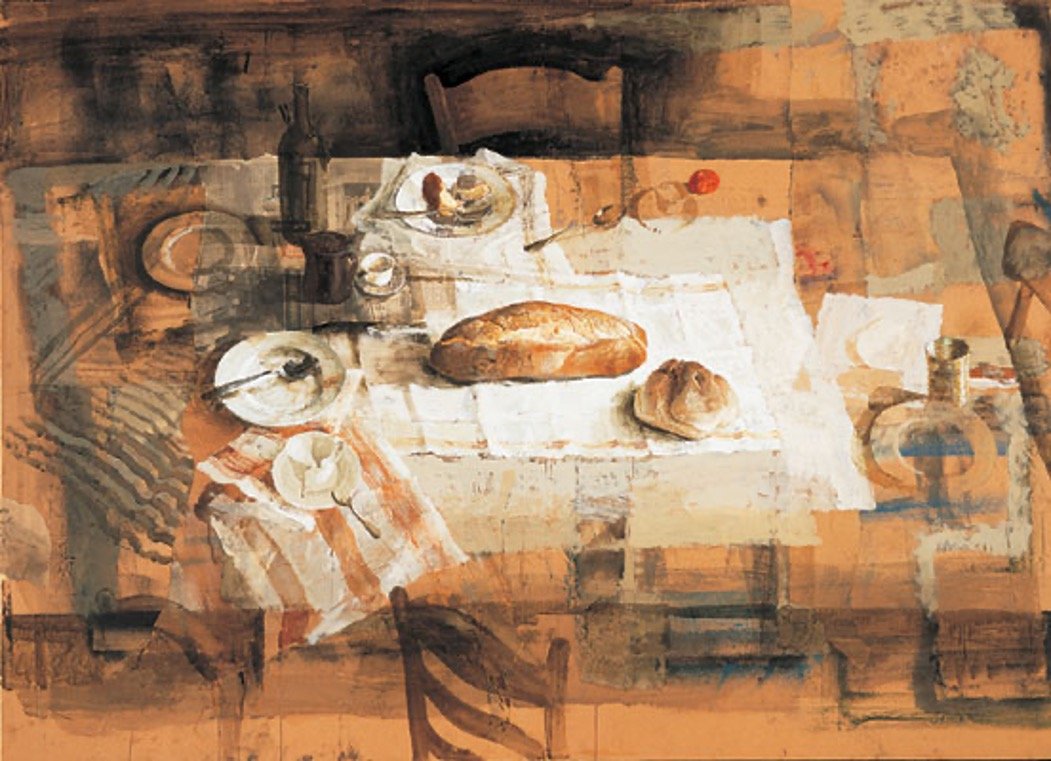
Safet Zec, Veliki stol s hljebom, 1996-2001
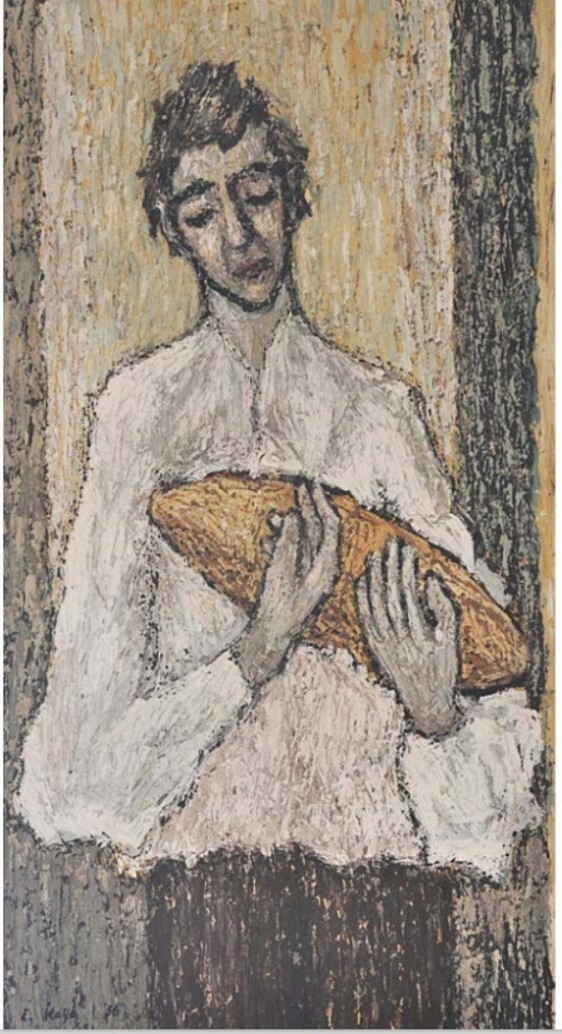
Enver Štaljo – Young Man with Bread, 1956, tempera on cardboard, 94.5×51.5 cm, property of City of Banja Luka
More of still life we can find in the works of Behaudin Selmanović.
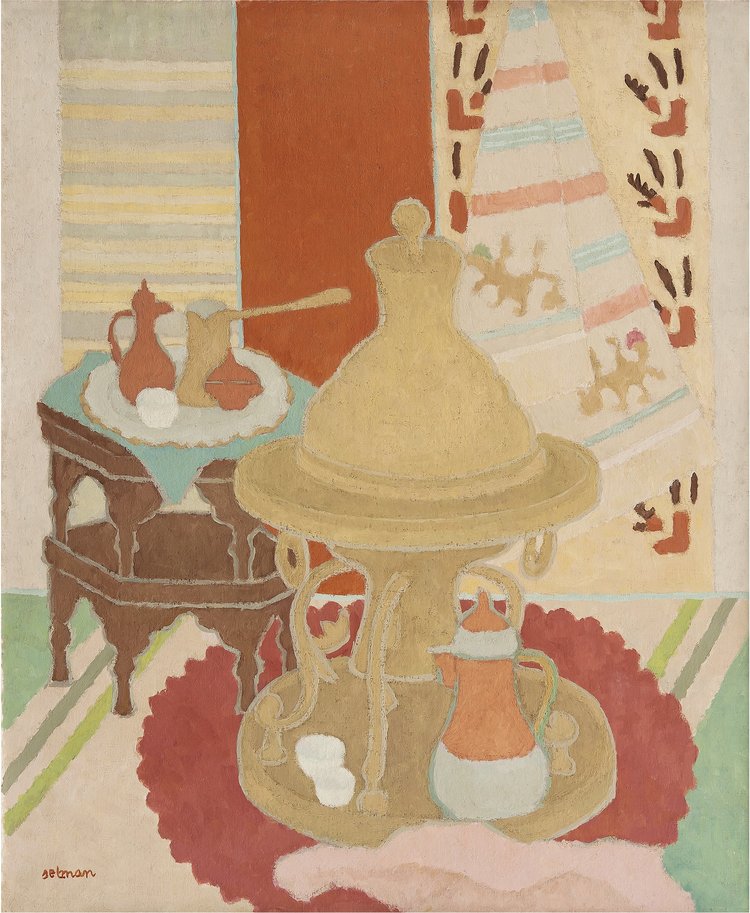
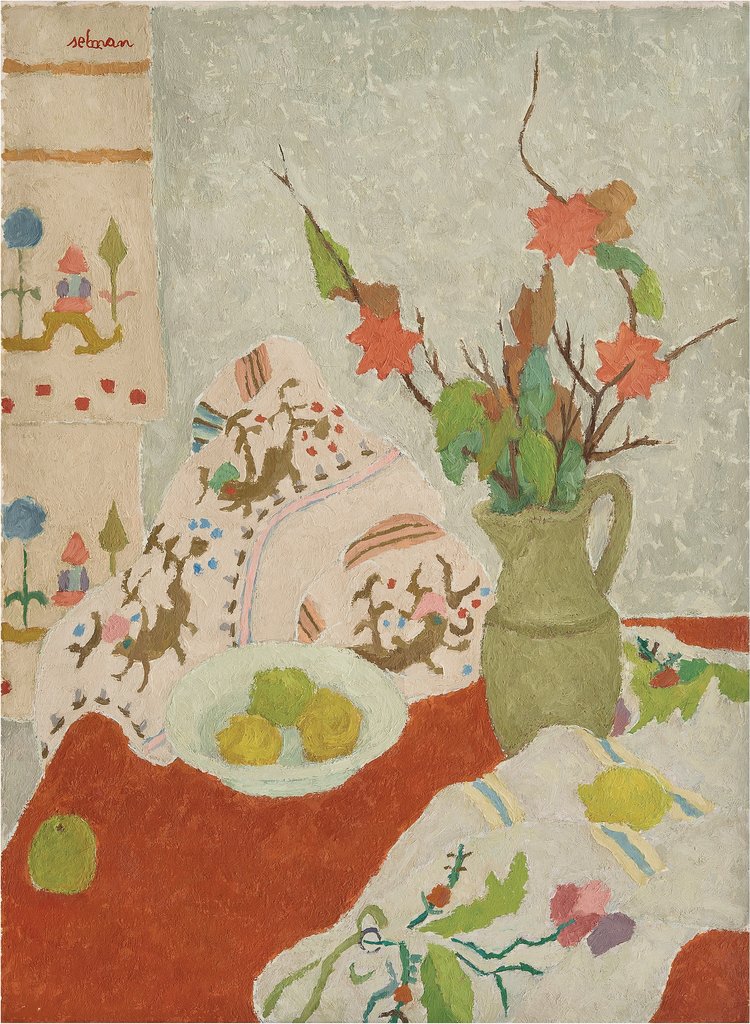
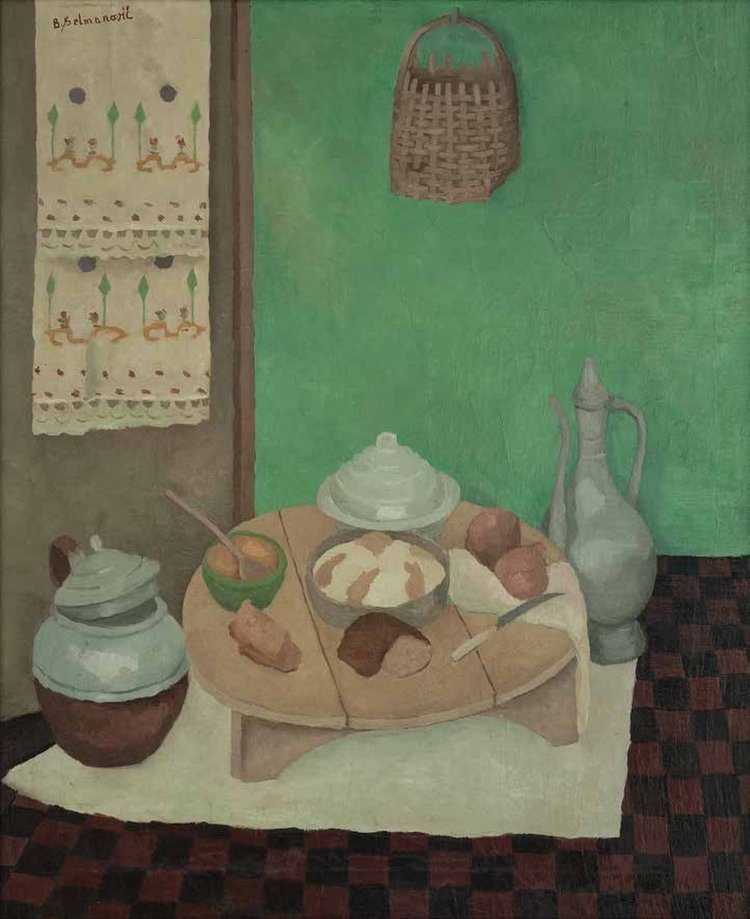
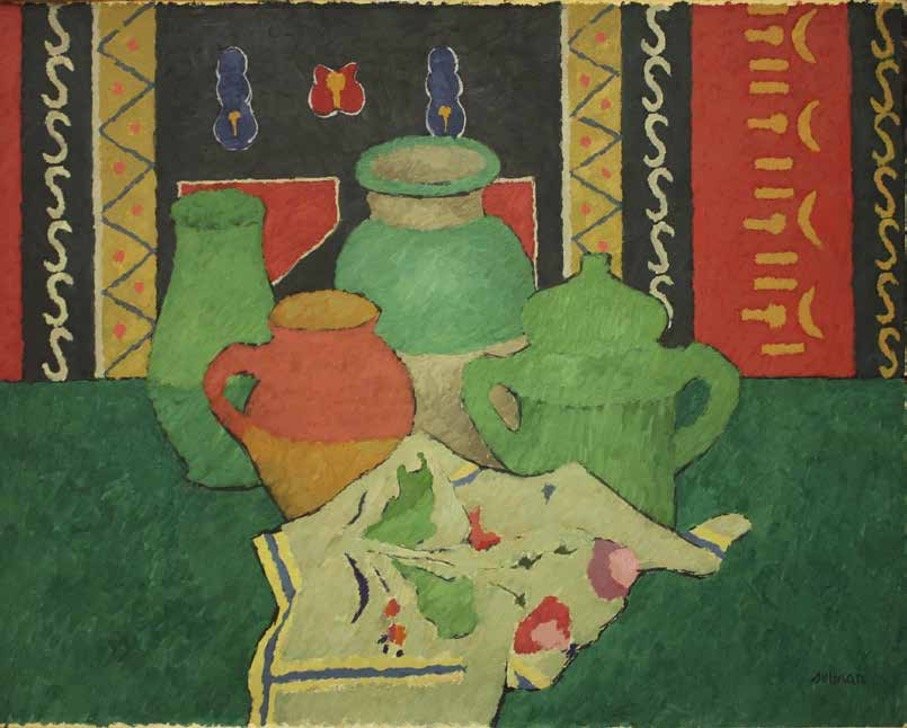
National Gallery of Bosnia and Herzegovina, Behaudin Selmanović Mrtva priroda sa ćupovima, oil on canvas, 73×92 cm, object n. 384
These make us rethink how we serve food for others.
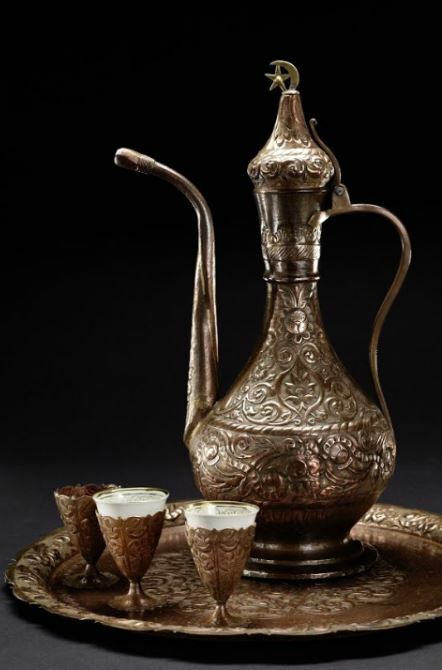
Mocha set, late 19th century, Mostar, Bosnia, copper, chased, porcelain, Museum Europäischer Kulturen, Staatliche Museen zu Berlin
We want everything to be nice and clean, we choose the best sets for coffee, we lay tables with beautiful stuff to show how much we care for who we host. We want them to have a good time.
But do we do that for ourselves?
Do we serve ourselves beautiful antique plates and a bouquet of flowers on the table, when we eat?
When we are alone, do we even eat at the table?
But do we do that for ourselves?
Do we serve ourselves beautiful antique plates and a bouquet of flowers on the table, when we eat?
When we are alone, do we even eat at the table?
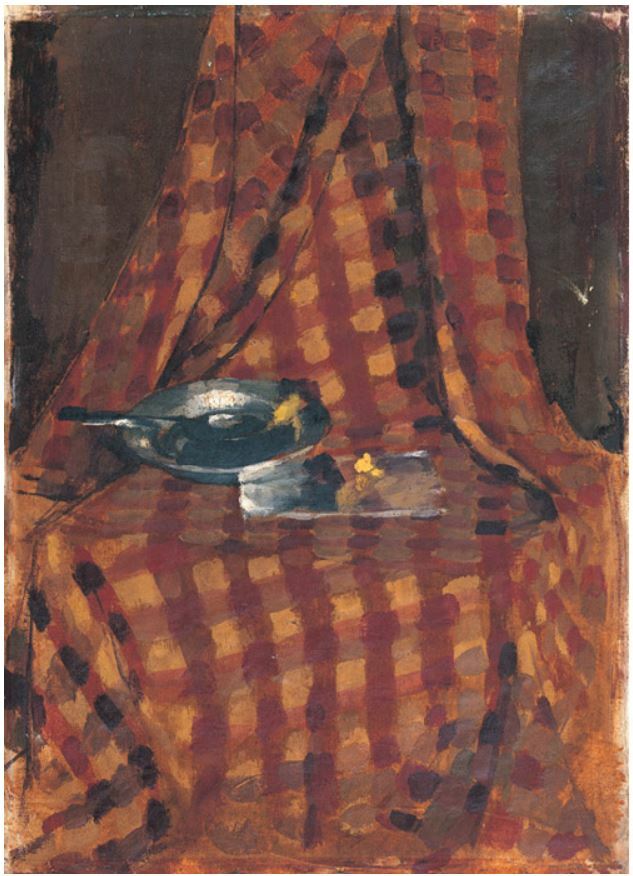
Safet Zec, 1962
This work by Safet Zec may portray just that.
How we grab the last clean plate or some from more or less clean, eat while working or how we make a quick very basic meal for 5 minutes.
Funny, that we would never do that to the ones we love.
How we grab the last clean plate or some from more or less clean, eat while working or how we make a quick very basic meal for 5 minutes.
Funny, that we would never do that to the ones we love.
HOW WE WANDER
Out of the blue, we get robbed of our homes.
Wandering and living on the run goes through the works of Ismet Mujezinović, as well as through graphics of Mevludin Ekmečić.
Wandering and living on the run goes through the works of Ismet Mujezinović, as well as through graphics of Mevludin Ekmečić.
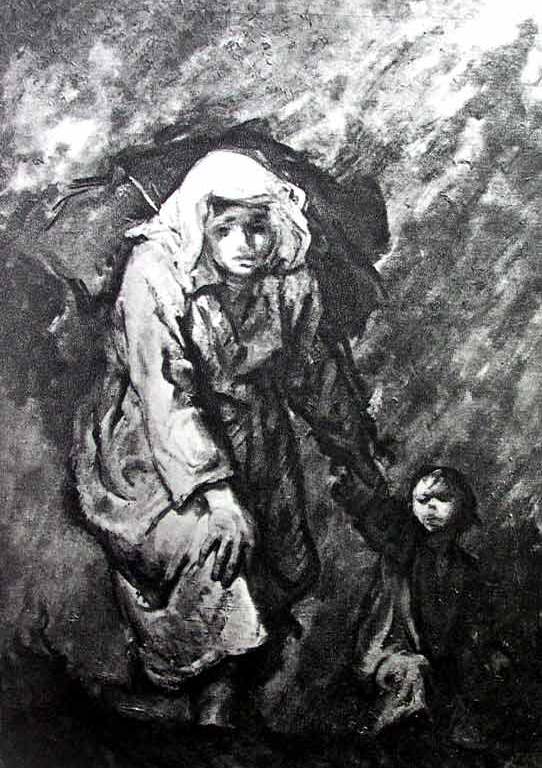
National Gallery of Bosnia and Herzegovina, Ismet Mujezinović Zbijeg, ulje na platnu, 100yx70 cm, object n. 234
You take your kid by the hand and you run. It may be war, it may be poverty, it may be ambition for a better life. All you know is that it’s never gonna be easy.
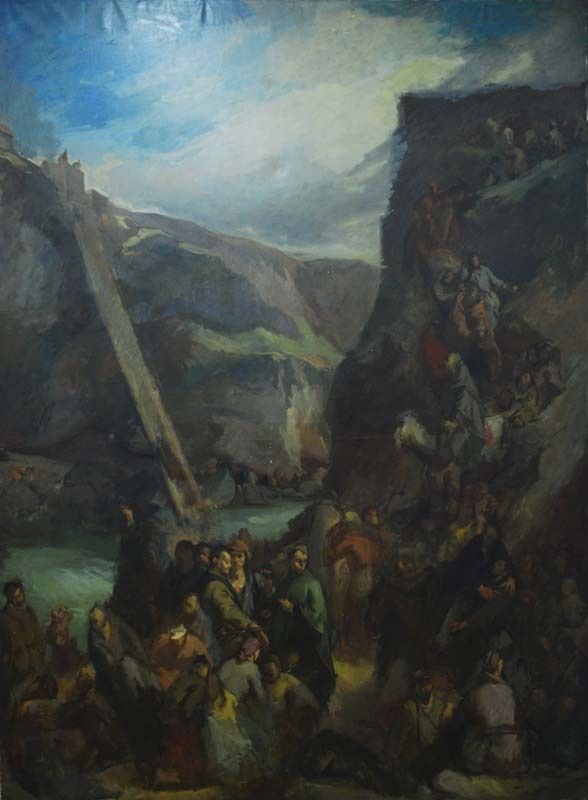
Ismet Mujezinović, Neretva battle, Centar za kulturu Tuzla
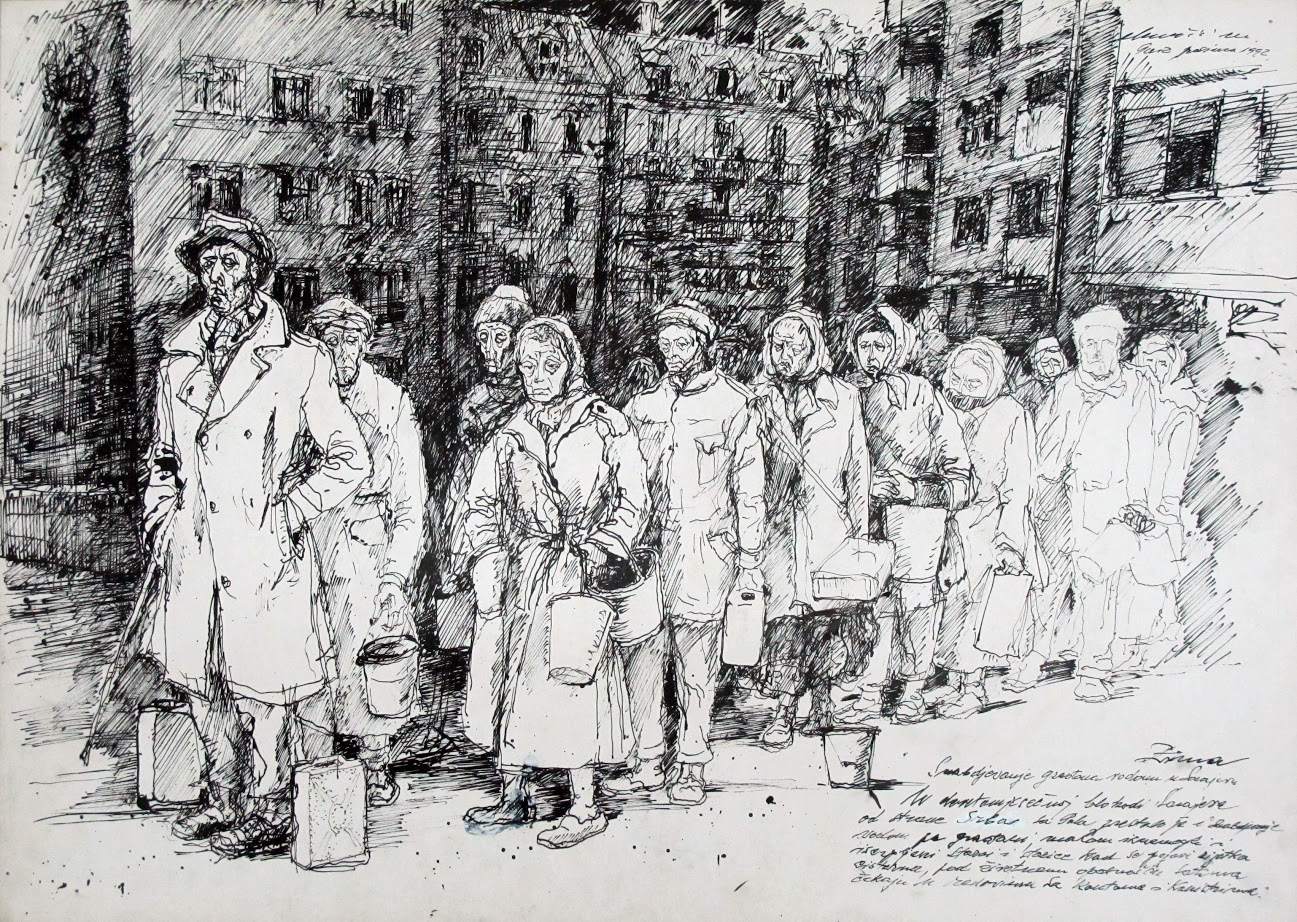
Mevludin Ekmečić, Winter, Bosnia, 1992-93. Art Collection of the Bosniak Institute – Fondation of Adil Zulfikarpašić
We can find the same story in some older works, like this painting by Roman Petrović.
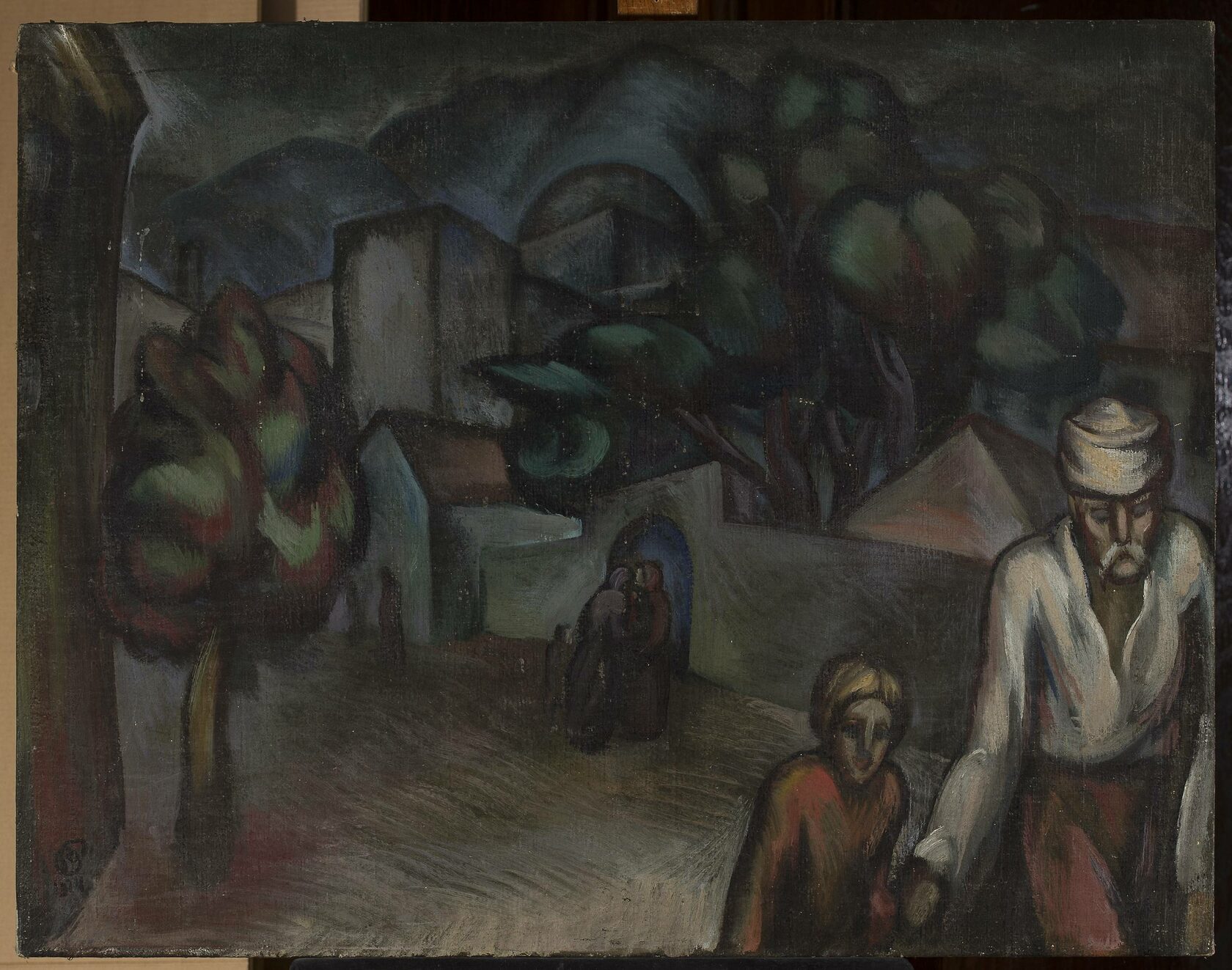
The National Museum in Warsaw, Roman Petrović, City landscape with figures, 1924
If you’re lucky, you have time to pack your stuff. If not, at some point of your life you just walk out of that door and never come back.
How time freezes, when this happens, is captured by the artist Edin Numankadić in his installation ‘Traces of War’. It shows the artist’s studio as it was in Sarajevo when the city was under siege.
How time freezes, when this happens, is captured by the artist Edin Numankadić in his installation ‘Traces of War’. It shows the artist’s studio as it was in Sarajevo when the city was under siege.
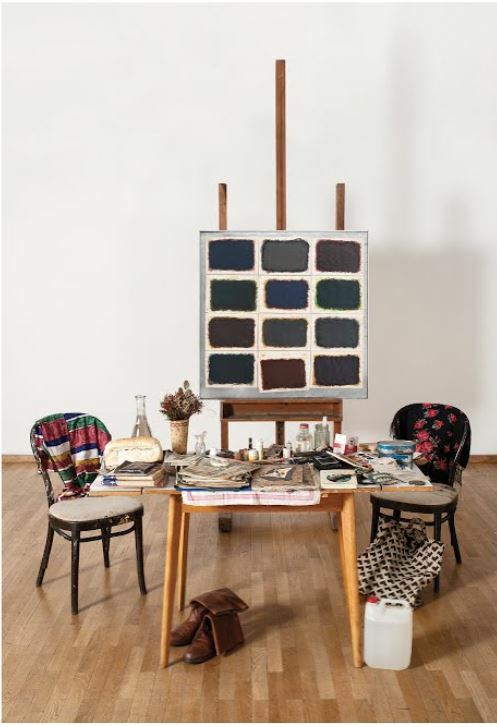
National Gallery of Bosnia and Herzegovina, Edo Numankadić Ratni tragovi, 1993. installation, object n. 5269
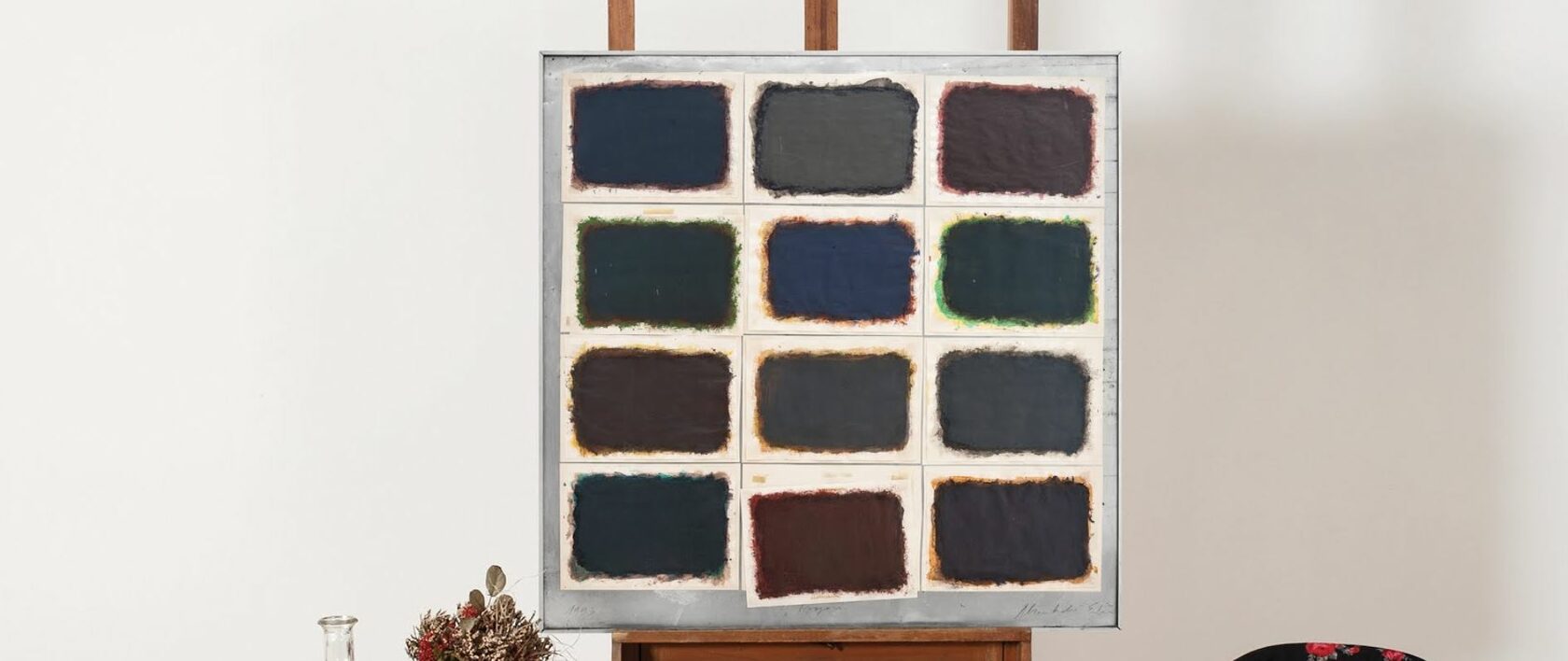
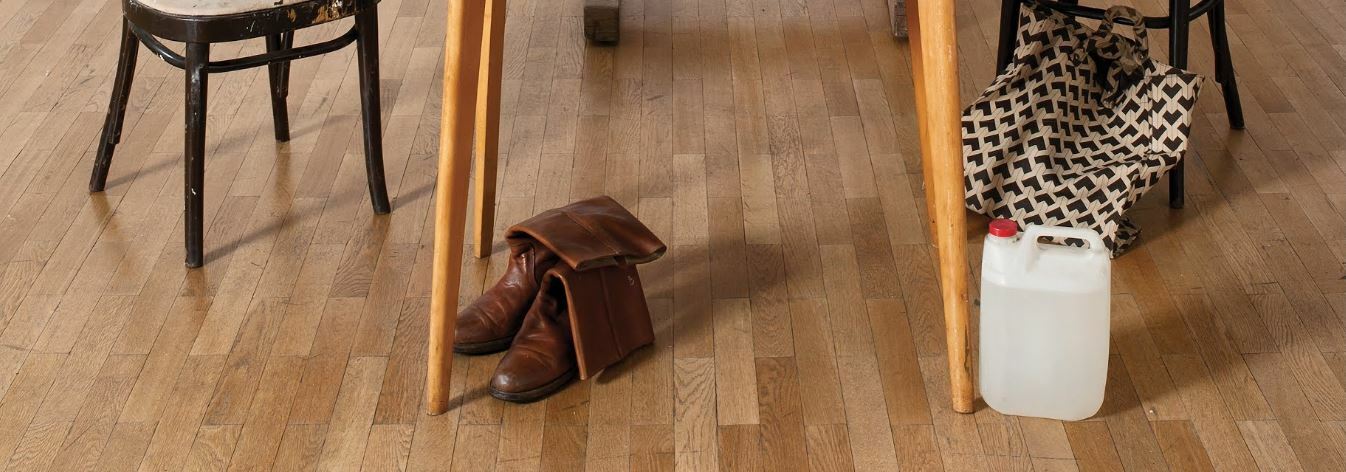
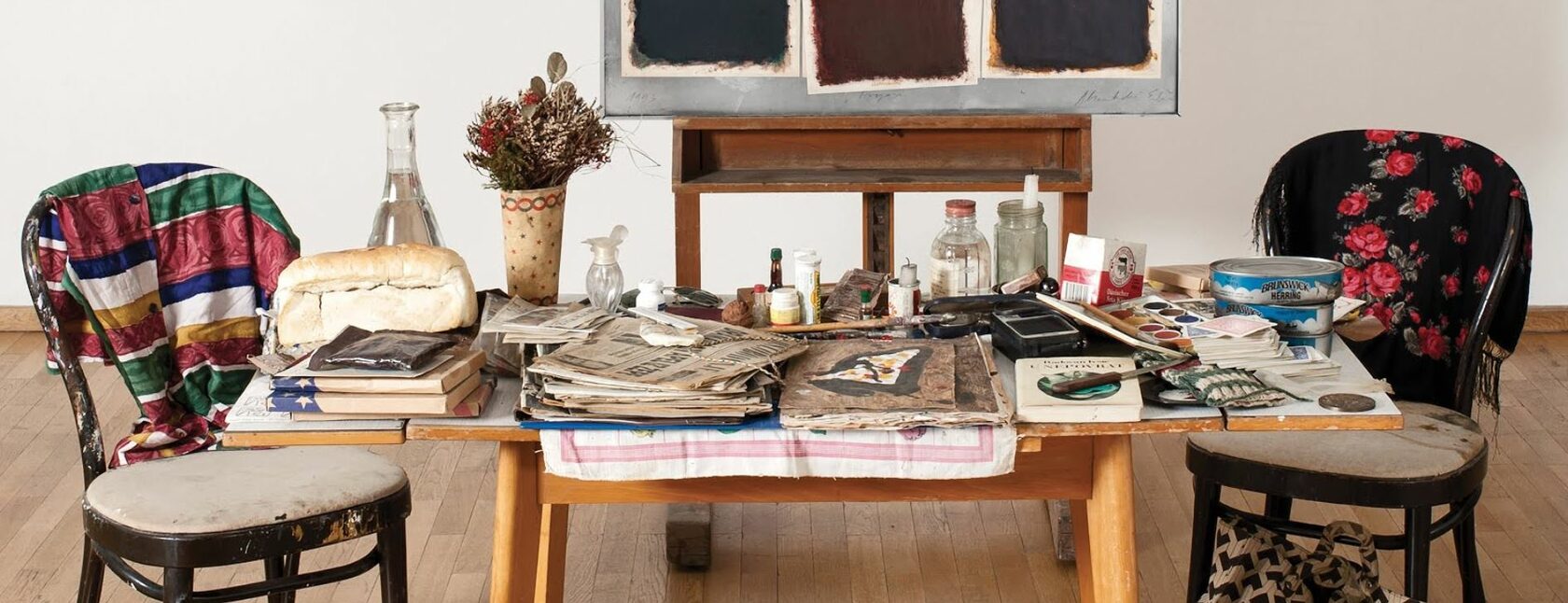
Suddenly, you don’t know what is the essential stuff that you may need. A diary? Warm clothes? Food? Water? A book? A photo of the one you love? Meds? A lipstick?
And it is not only about what you have to take, but also what you have to leave behind.
Suddenly, you have to prioritise within something like 5 minutes.
And when you find another home, it’s never the same as the one you left. It’s rather just some space you occupy.
New languages sound vague, cities look indistinct, new faces seem blurred.
(These are how it feels to live away from home)
And it is not only about what you have to take, but also what you have to leave behind.
Suddenly, you have to prioritise within something like 5 minutes.
And when you find another home, it’s never the same as the one you left. It’s rather just some space you occupy.
New languages sound vague, cities look indistinct, new faces seem blurred.
(These are how it feels to live away from home)
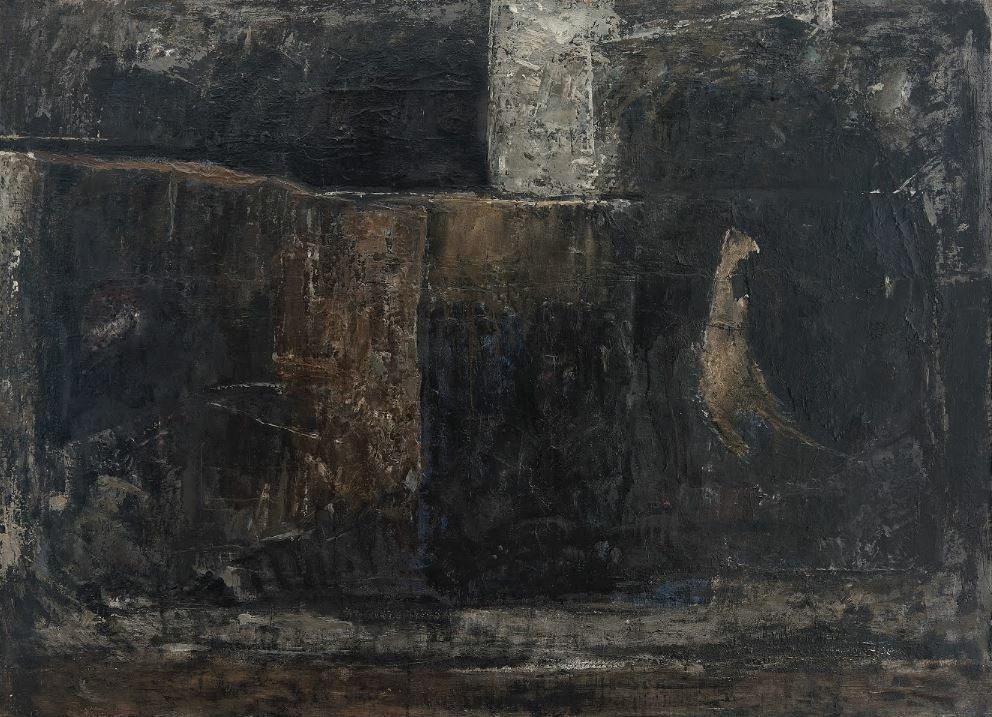
National Gallery of Bosnia and Herzegovina, Mensur Dervišević Prostor, oil on canvas, 70,5×99,5 cm, object n. 2961
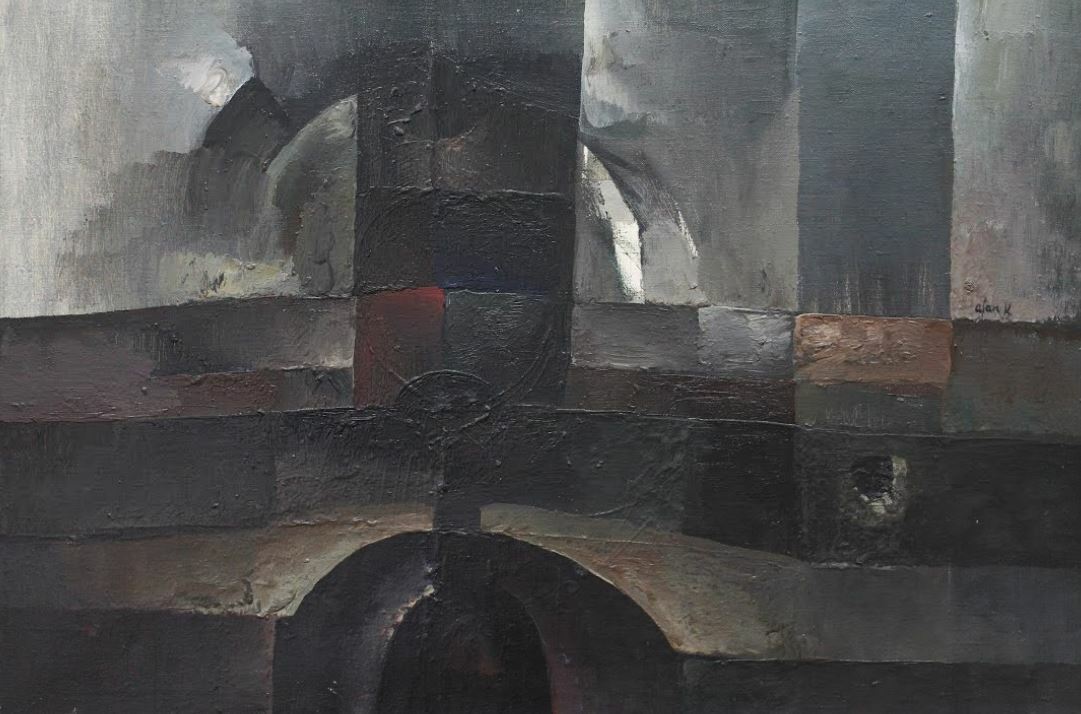
National Gallery of Bosnia and Herzegovina, Afan Ramić Predio sa dugom, ulje na platnu, 50,7×72,5 cm, object n. 2383
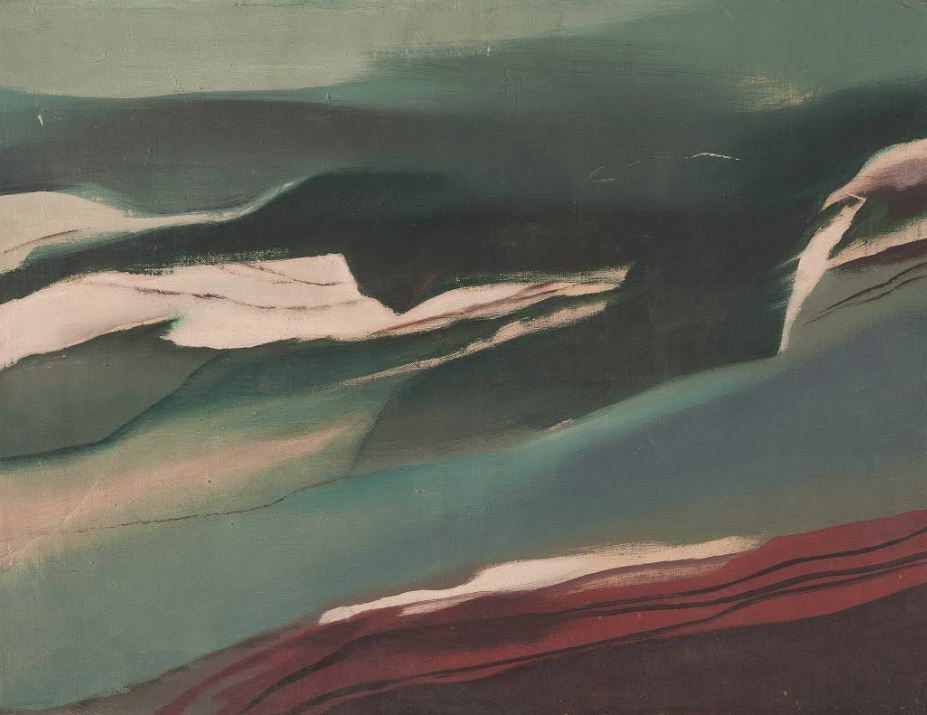
National Gallery of Bosnia and Herzegovina, Milorad Ćorović Igman, oil on canvas, 50×65, object n. 3229
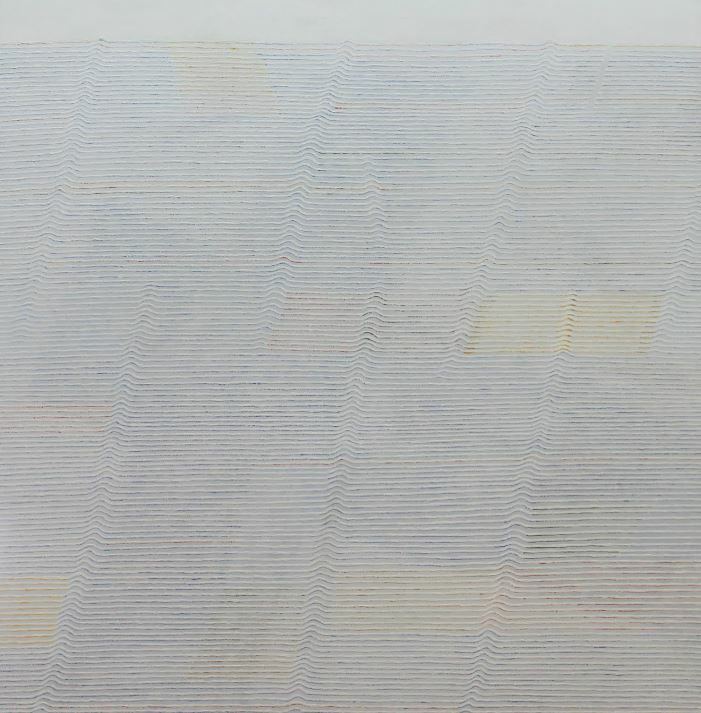
National Gallery of Bosnia and Herzegovina, Bekir Misirlić Bijela visoravan, 1981. oil on canvas, 135×135 cm, object n. 3750
Then, after long months and years, you sort of start to see the place. Like this white noise, that Bekir Misirlić portrayed, is getting shaped into your new home.
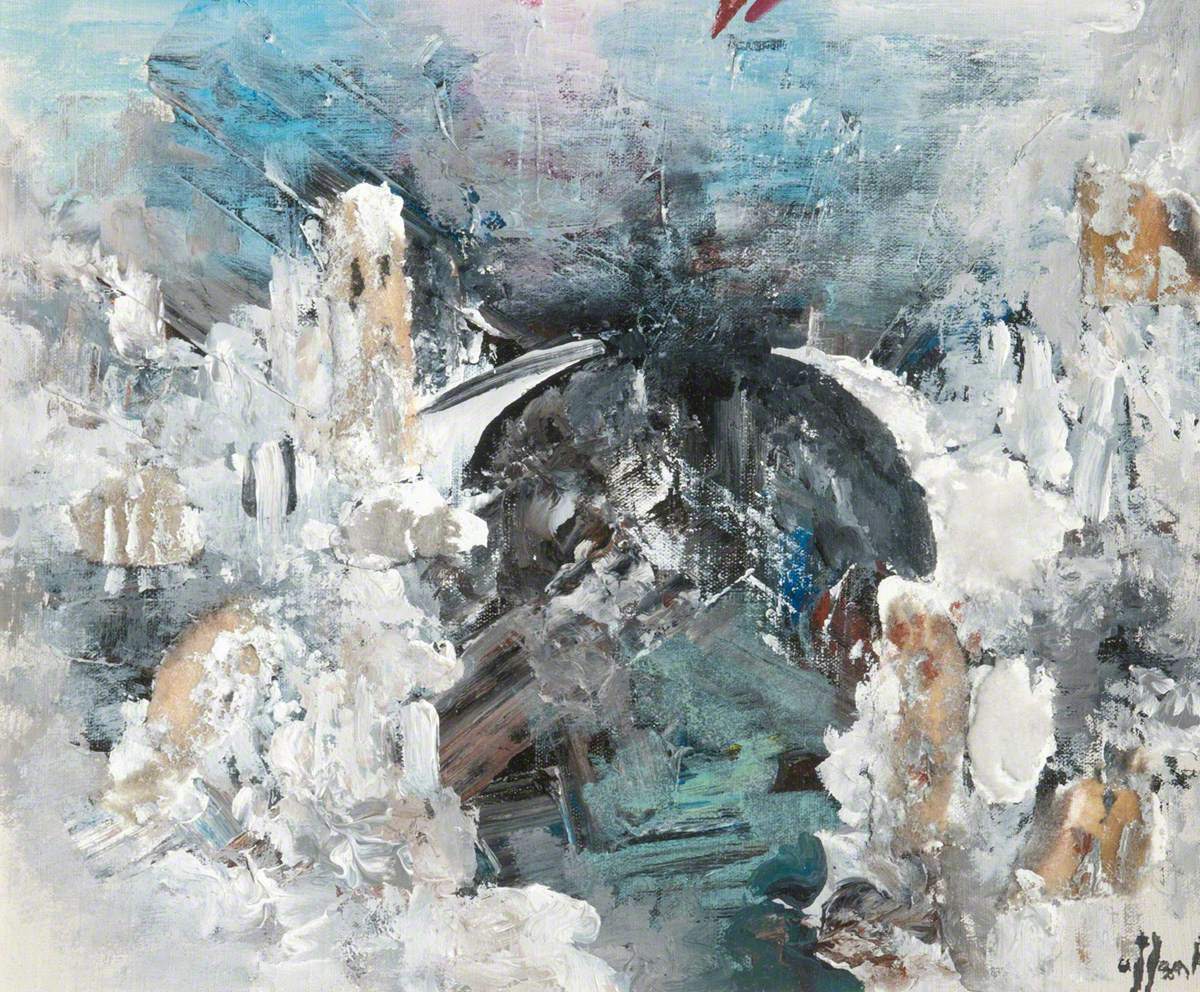
Bridge over the River Neretva by Affan Ramić (1932-2015), Royal Victoria Hospital, Belfast. Image courtesy of the Belfast Health and Social Care Trust
They start asking questions, we are always having these silly small talks on what we were and where we lived.
It’s described by the poet Mak Dizdar:
It’s described by the poet Mak Dizdar:
Once upon a time a worthy caller asked:
Who is that what is that forgive
Where is that
Whence is that
Where to is
That
Bosnia
Tell
And the questioned gave then a prompt reply to him:
Bosnia forgive there is a land
Both barren and barefoot forgive
Both cold and hungry
And even more
Forgive
Defiant
By
A dream”.
Who is that what is that forgive
Where is that
Whence is that
Where to is
That
Bosnia
Tell
And the questioned gave then a prompt reply to him:
Bosnia forgive there is a land
Both barren and barefoot forgive
Both cold and hungry
And even more
Forgive
Defiant
By
A dream”.
The saddest thing of all is that they will never really feel how beautiful, how rich, how hospitable our motherlands were.
Until they weren’t.
Until they weren’t.
HOW WE DIE
Death may scare us in many ways.
By creating a family and having children we also create a reminder of our age and that life is heading to its logical finish. That may be a tough one.
By creating a family and having children we also create a reminder of our age and that life is heading to its logical finish. That may be a tough one.
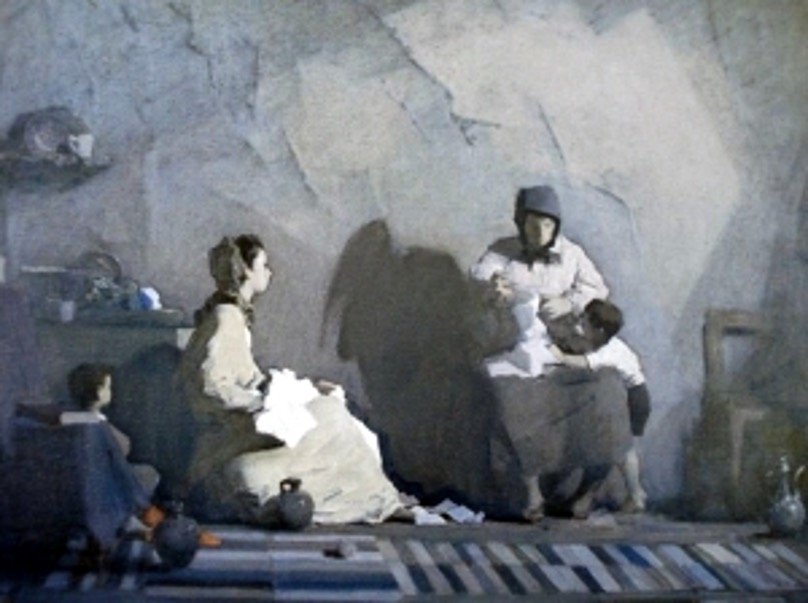
t107__title U interijeru, 1978
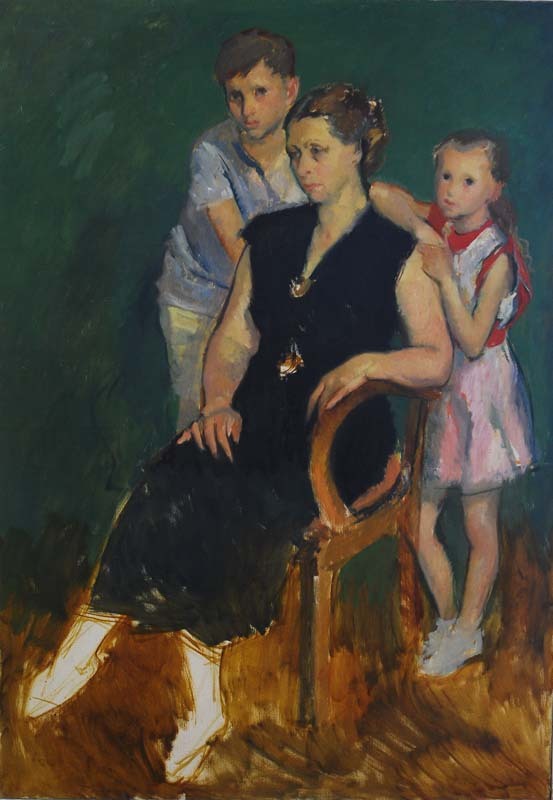
Ismet Mujezinović, Marija (Ismets wife, with their 2 children), Centar za kulturu Tuzla
Or vice versa, being in the position of children, we will inevitably feel how parents slip away from our hands every day.
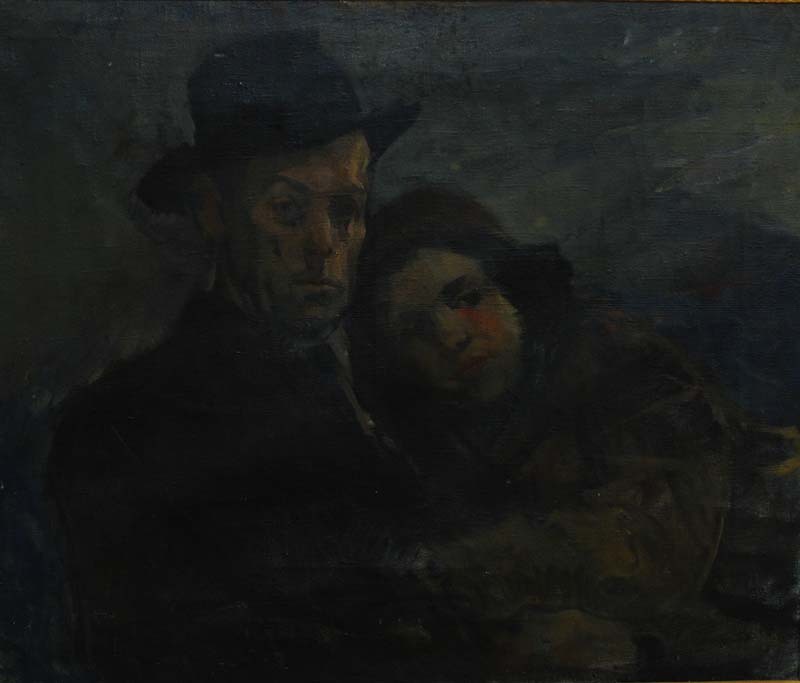
Ismet Mujezinović, Meša Selimović with his wife Darka, Centar za kulturu Tuzla
Or we may think of someone we’ve already lost – anything, anyone may be a reminder of impending death, which is not necessarily a bad thing, or good.
“It takes the whole of life to learn how to live, and – what will perhaps make you wonder more – it takes the whole of life to learn how to die”, – Lucius Seneca wrote this in the moral essay ‘On the Shortness of Life’. And it makes perfect sense.
On life and death, Đoko Mazalić created his painting ‘Mary Magdalene’ in 1936-37.
“It takes the whole of life to learn how to live, and – what will perhaps make you wonder more – it takes the whole of life to learn how to die”, – Lucius Seneca wrote this in the moral essay ‘On the Shortness of Life’. And it makes perfect sense.
On life and death, Đoko Mazalić created his painting ‘Mary Magdalene’ in 1936-37.
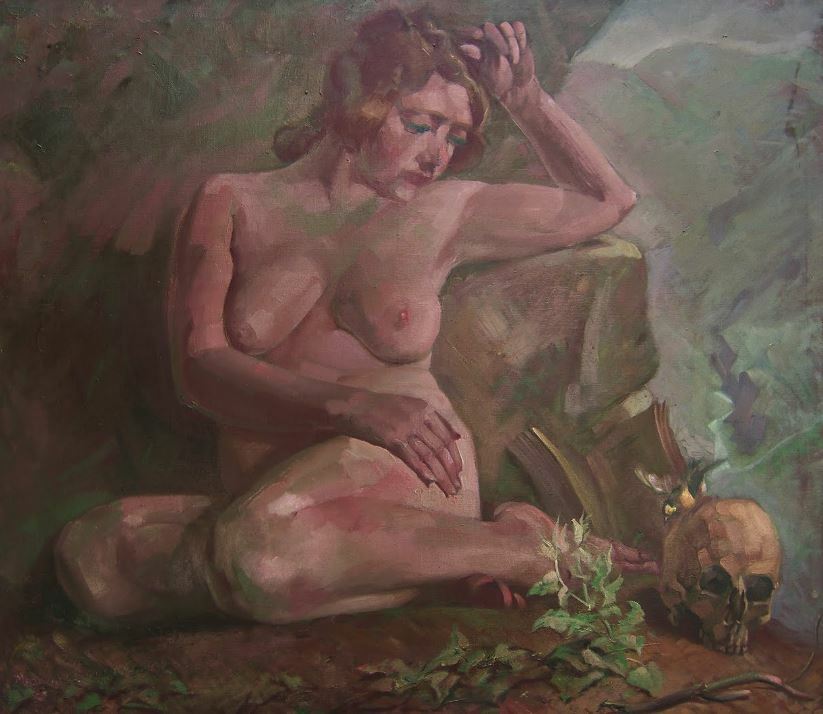
National Gallery of Bosnia and Herzegovina, Đoko Mazalić Magdalena, around 1936/7, oil on canvas, 120×136 cm, object n. 3226
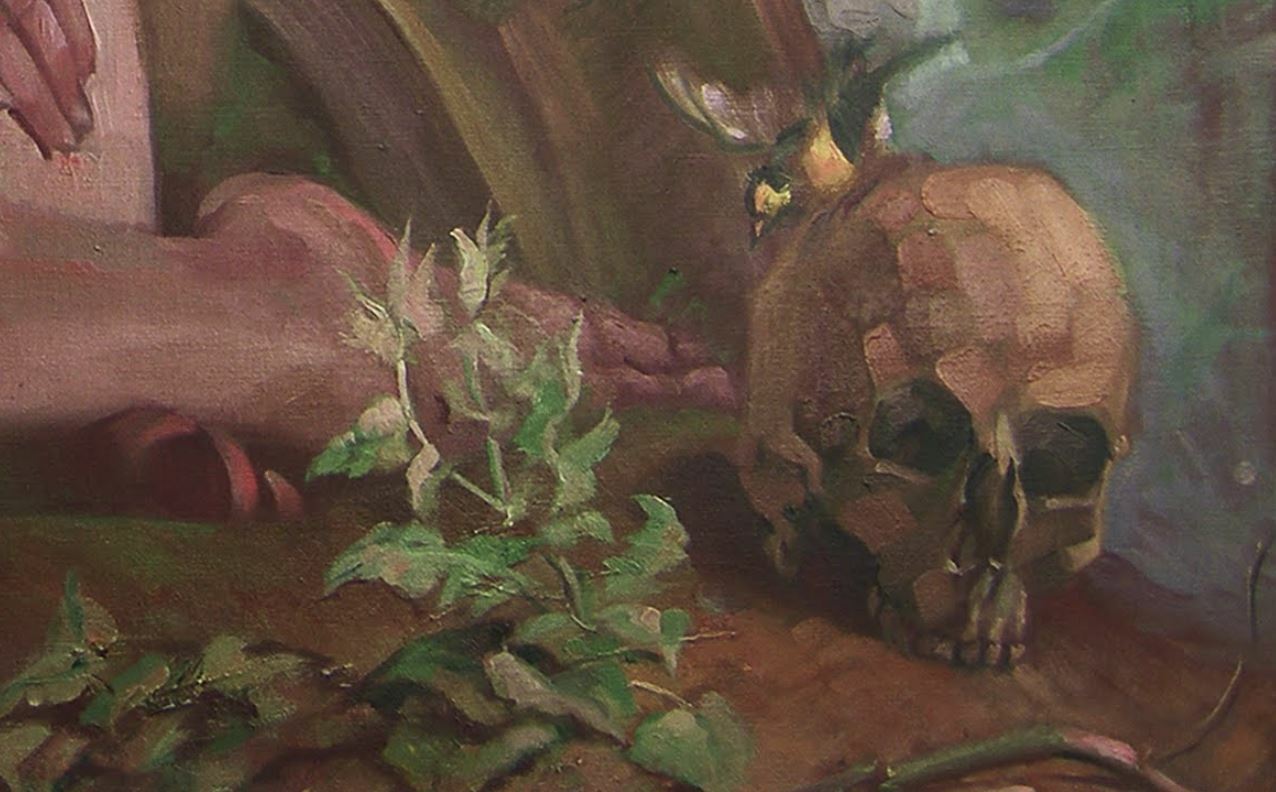
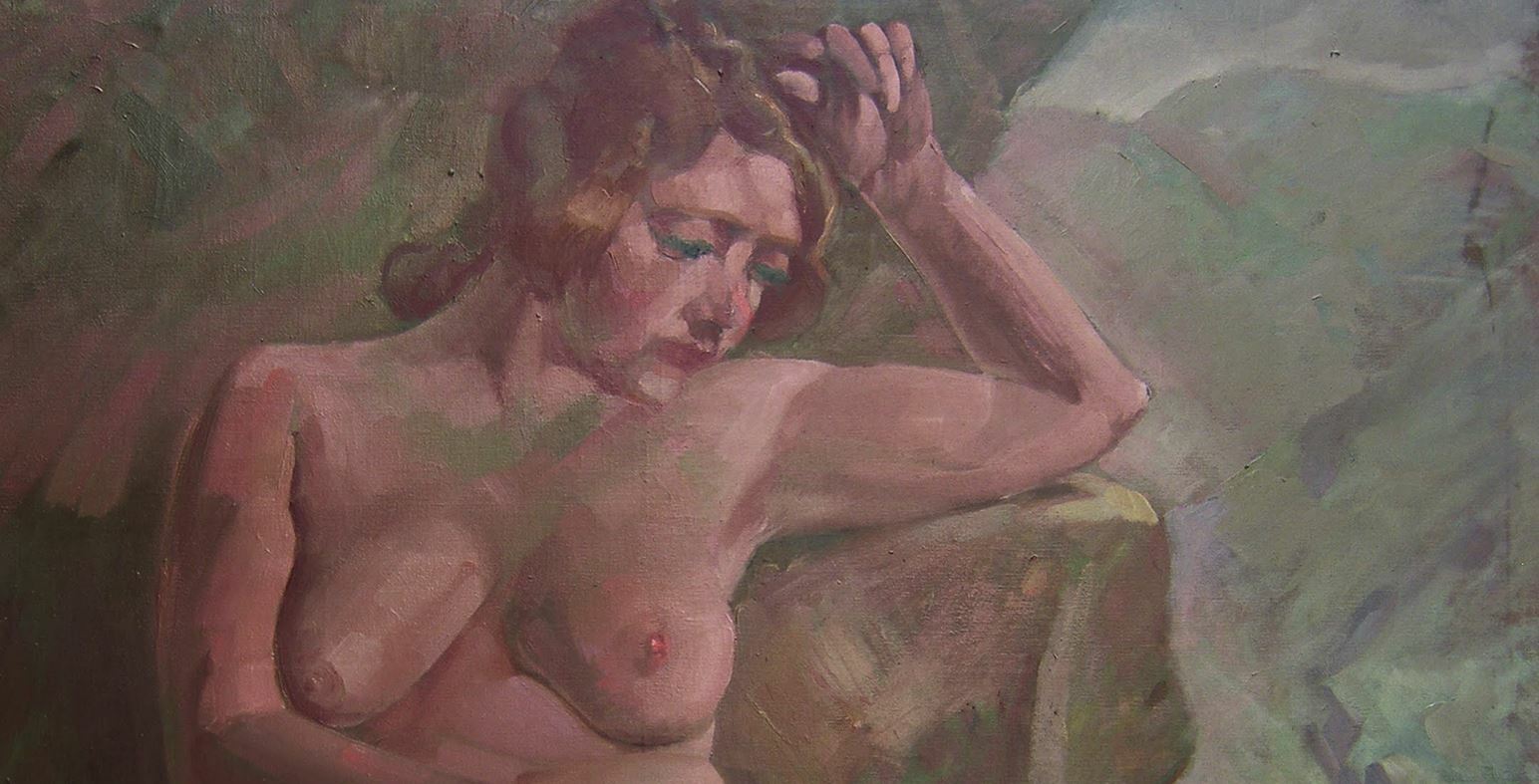
We can see a young naked woman sitting on the ground. She looks down to the skull next to her and seems not to notice the green sprout alongside.
It’s truly fascinating about this piece how life and death lay down at the feet of this woman, and how eloquently calm the look of her eyes seems.
There is no fear, no anxiety, no effort to escape.
We read in Ecclesiastes 3: ‘There is a time for everything, and a season for every activity under the heavens…’
What Mazalić created with his ‘Mary Magdalene’ is a perfect illustration for ‘there is a time to be born and a time to die’.
We have time and opportunity to reflect on what kind of person we have been through life.
We can meet our identities: we have been students, friends, husbands and wives, workers, players, believers, cheaters, traitors, anything…
Just like Salim Obralic decided to divide painting ‘Women from Kosova near Maglaji’ in two halves – a blurry and a clear – our memories appear.
It’s truly fascinating about this piece how life and death lay down at the feet of this woman, and how eloquently calm the look of her eyes seems.
There is no fear, no anxiety, no effort to escape.
We read in Ecclesiastes 3: ‘There is a time for everything, and a season for every activity under the heavens…’
What Mazalić created with his ‘Mary Magdalene’ is a perfect illustration for ‘there is a time to be born and a time to die’.
We have time and opportunity to reflect on what kind of person we have been through life.
We can meet our identities: we have been students, friends, husbands and wives, workers, players, believers, cheaters, traitors, anything…
Just like Salim Obralic decided to divide painting ‘Women from Kosova near Maglaji’ in two halves – a blurry and a clear – our memories appear.
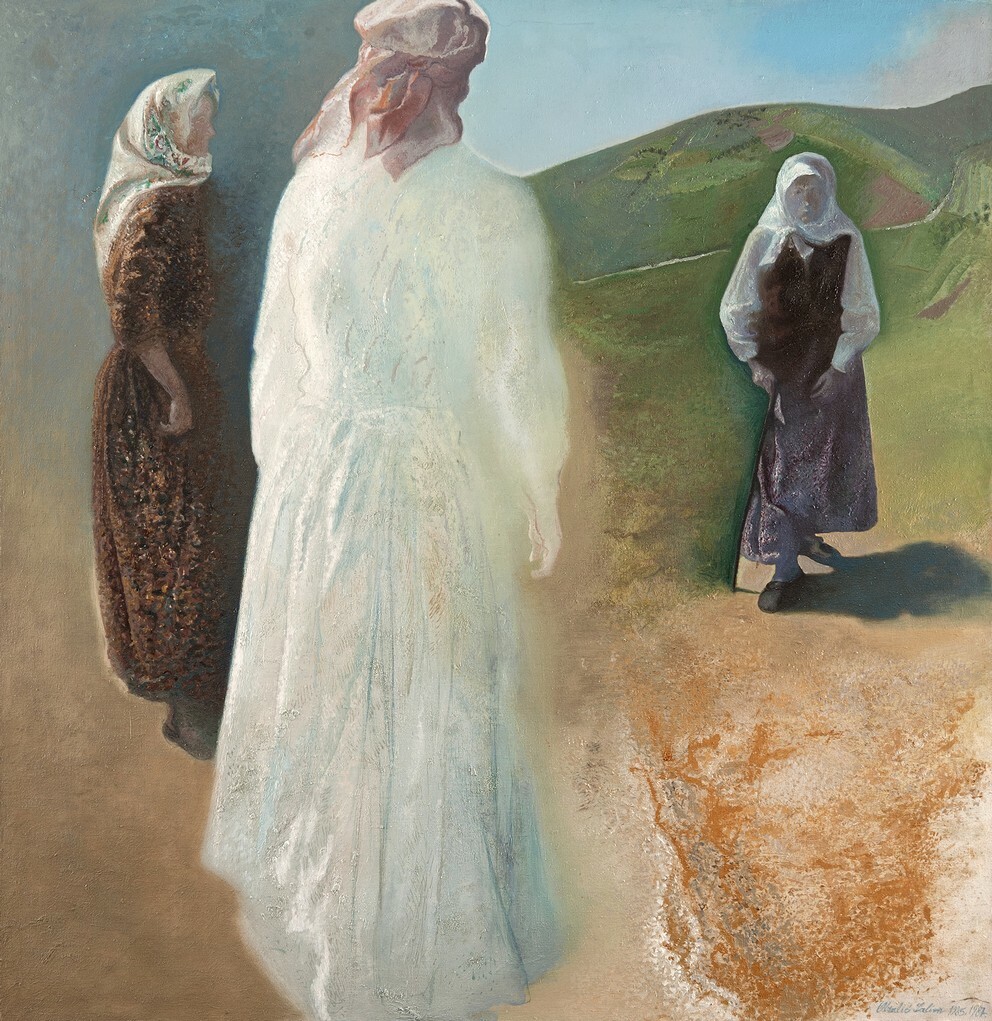
Salim Obralic, Women from Kosova near Maglaji, 1985, Galerija AB Maglaj
It’s like we have the chance to look ourselves in the eyes and tell if there are any regrets.
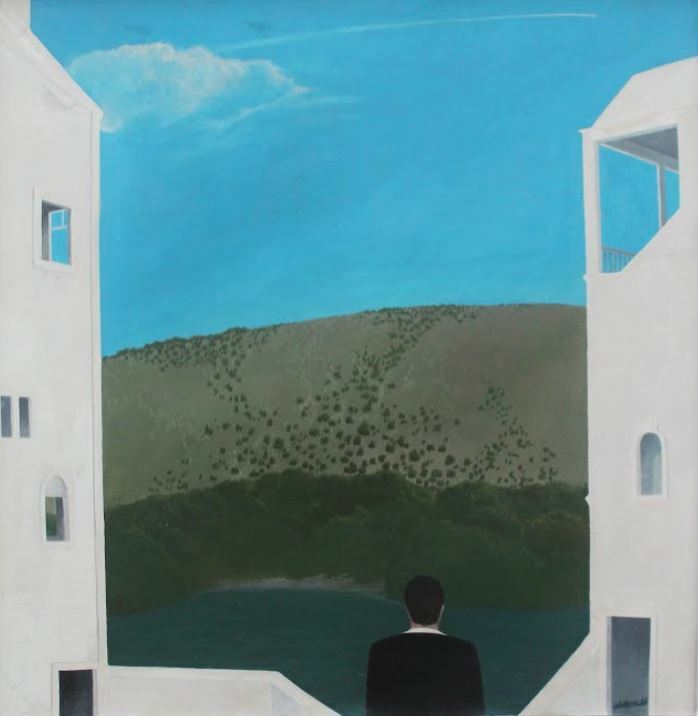
Narcis Kantardžić, Landscape, 1986
It became clear to me how men die. I saw that it is not so hard. Or easy. It is nothing.
One just starts living less and less, being less and less, thinking, feeling and knowing less and less.
The rich flow of life dries up, and only a thin thread of uncertain consciousness remains, more and more meager, more and more insignificant.
And then nothing happens, there is not anything, there is nothing.
And nothing matters—it is all the same”, –
One just starts living less and less, being less and less, thinking, feeling and knowing less and less.
The rich flow of life dries up, and only a thin thread of uncertain consciousness remains, more and more meager, more and more insignificant.
And then nothing happens, there is not anything, there is nothing.
And nothing matters—it is all the same”, –
from ‘Death and the Dervish’ by Meša Selimović.
And then, it’s done.
And then, it’s done.
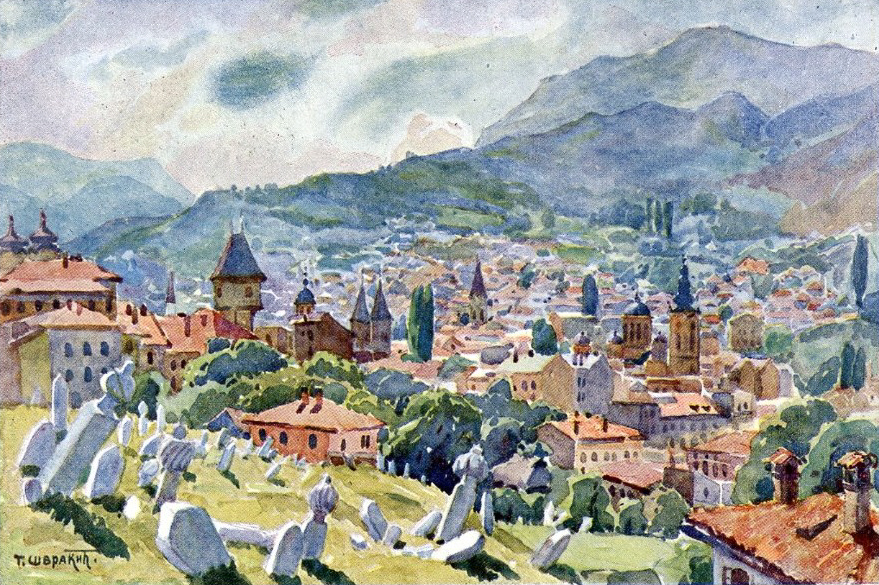
Todor Švrakić, Panorama of Sarajevo, postcard, sent in 1923
HOW WE REACH IMMORTALITY
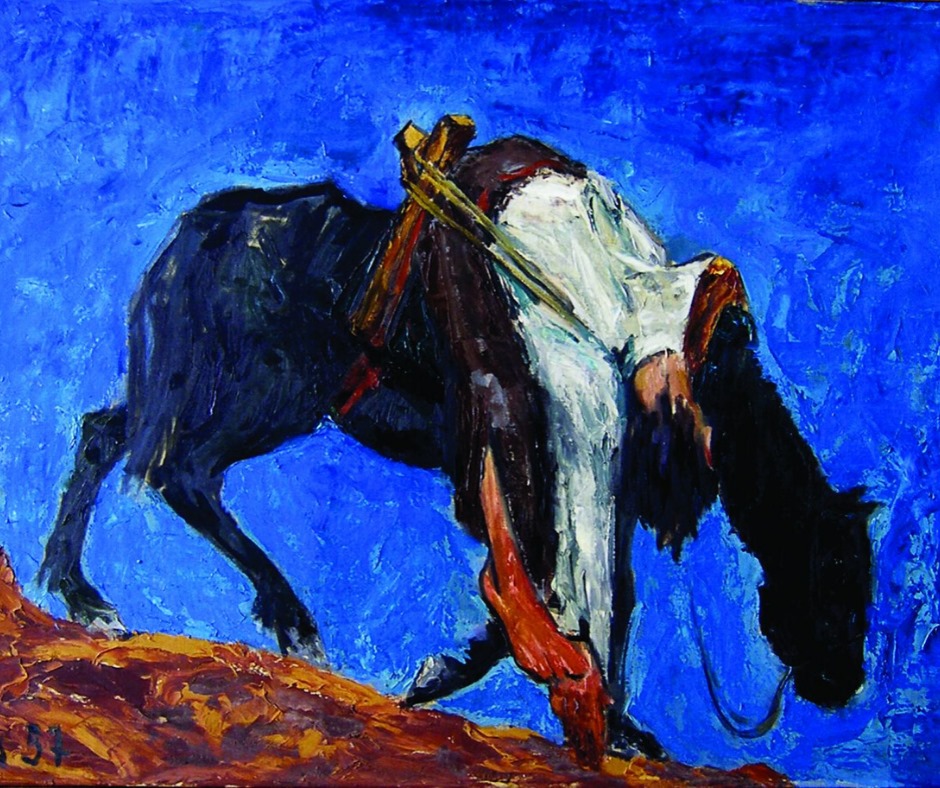
National Gallery of Bosnia and Herzegovina, Vojo Dimitrijević Tifusar, 1957, oil on cavas, 105×140 cm, object n. 413
The soldier’s name was Kara-Zaim. Now he was just a shadow of the former Kara-Zaim, a shabby remnant of that fearless youth who had rushed with his saber drawn against the drawn sabers of the enemy, until an uhlan ran one through his rib cage.
Until then he had been continually stabbed, cut, hacked, and maimed. One half of his left ear was missing, as were three fingers of his left hand; his face was furrowed with red scars where new skin had failed to grow in; he hid other scars under his clothes.
He had always recovered easily and gone back into battle.
His blood was strong and the deep cuts in his young flesh healed quickly”, –
Until then he had been continually stabbed, cut, hacked, and maimed. One half of his left ear was missing, as were three fingers of his left hand; his face was furrowed with red scars where new skin had failed to grow in; he hid other scars under his clothes.
He had always recovered easily and gone back into battle.
His blood was strong and the deep cuts in his young flesh healed quickly”, –
from ‘Death and the Dervish’ by Meša Selimović.
As the narrator, the Dervish, meets former brother in arms, the first thing that appears in his mind is Kara-Zaim’s heroism back in combat days.
Through the stories told about our lives, through legends and maybe even myths we reach immortality.
As the narrator, the Dervish, meets former brother in arms, the first thing that appears in his mind is Kara-Zaim’s heroism back in combat days.
Through the stories told about our lives, through legends and maybe even myths we reach immortality.
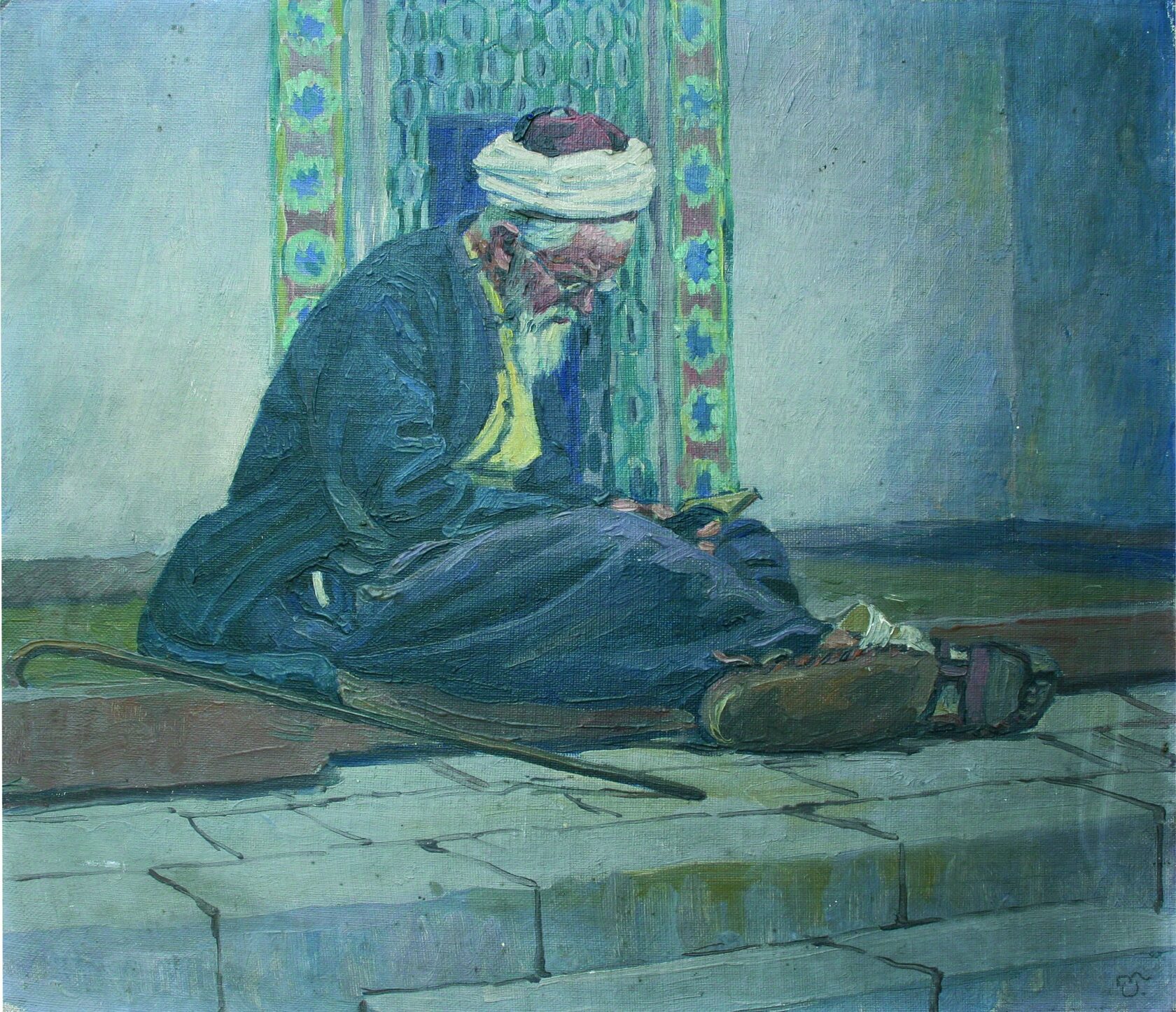
Muzej Sarajeva, Petar Tješić, Derviš pred džamijom, 1920s
Through the letters we write and pictures we make we reach immortality, because paper, canvas, stone, clay, you name it, will secure what we want to say for thousands and millions of years.
Just like Numankadić’s ‘Notes’ remind us of prehistoric rock paintings, we know that every word will be remembered.
Just like Numankadić’s ‘Notes’ remind us of prehistoric rock paintings, we know that every word will be remembered.
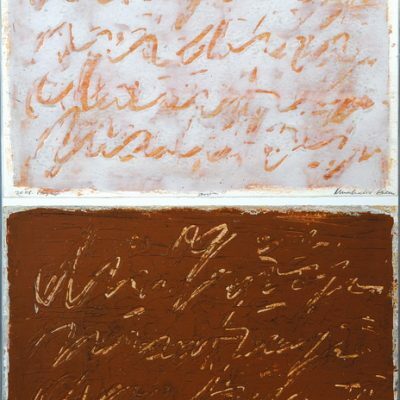
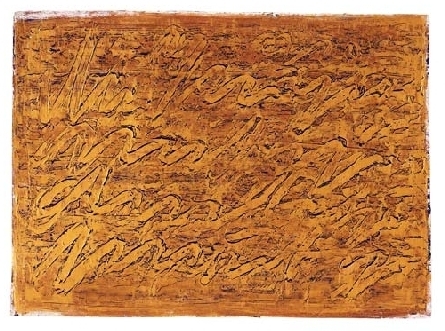
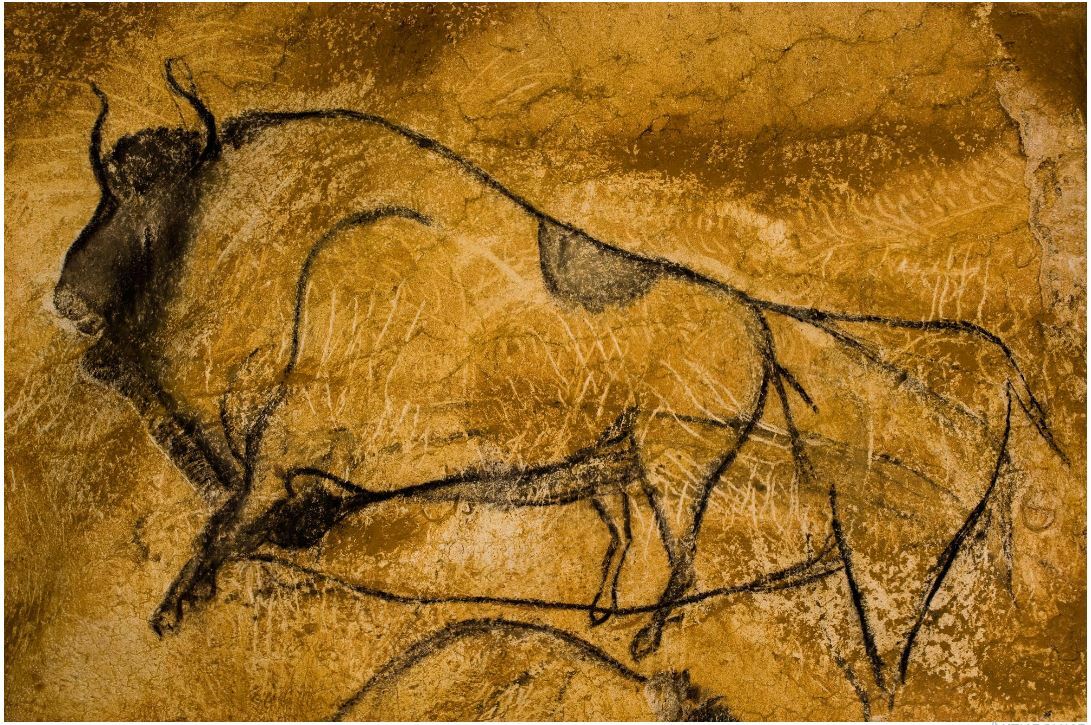
Edin Numankadić, The note 2, 2004
Through our kids we reach immortality, because they are the continuation of us.
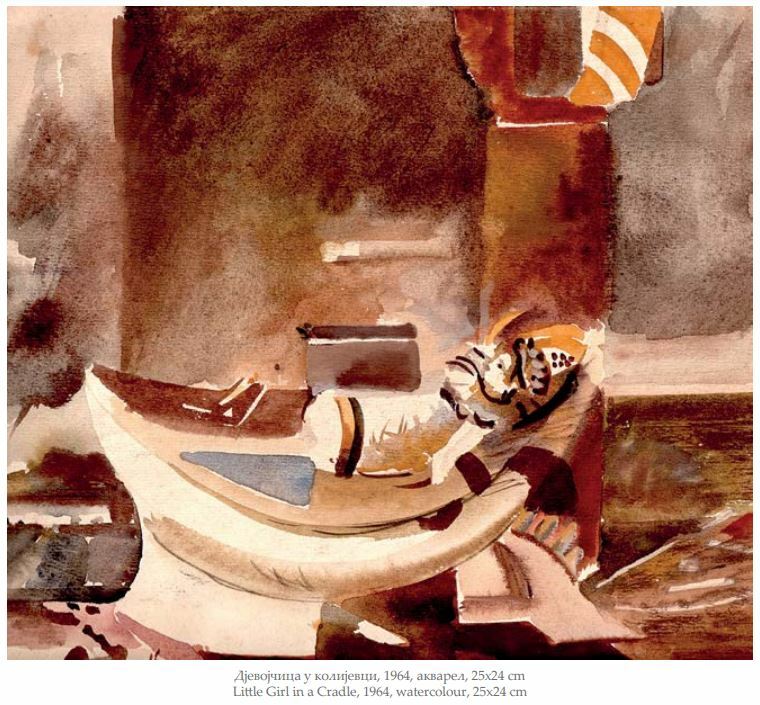
Muzej savremene umjetnosti Republike Srpske, Enver Štaljo, The little girl in the cradle, 1964
They come to this world and then everything repeats itself all over again.
Literature:
Selimović, Meša., Fabrio, Nedjeljko. Derviš i smrt. Hrvatska: Školska knjiga, 1980.
Mahmutćehajić, R., Risaluddin, S., Jones, F. R. (2011). Across the River: On the Poetry of Mak Dizdar. USA: Fordham University Press.

The preceding text is copyright of the author and/or translator and is licensed under a Creative Commons Attribution-NonCommercial-NoDerivs 3.0 Unported License.

